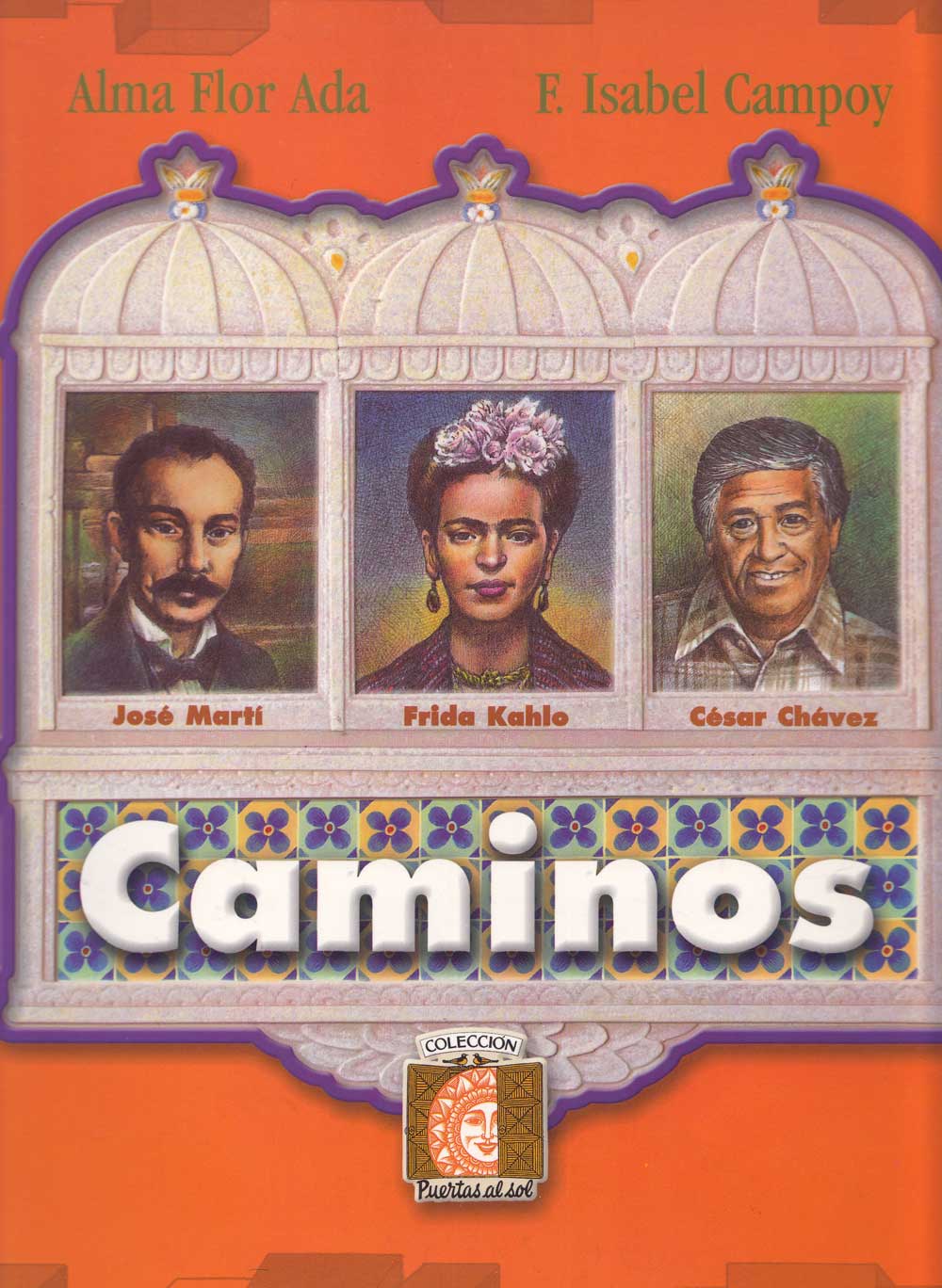 Puertas
al sol Colección Biografía
Puertas
al sol Colección BiografíaGateways to the Sun Biography Collection
 Puertas
al sol Colección Biografía
Puertas
al sol Colección Biografía
Gateways to the Sun Biography Collection
To Order or to Ask a Del Sol
Question,
read the Del Sol Order
Info and then email Rey Del Sol
![]()
Puertas
al sol Collección
Biografia Spanish
$122.03, Including 20%-Off, Free
Immediate Mailing, and No Sales Tax
10 Softcover Spanish Books : 4
Levels of Oversized Books, 3 Levels of Workbooks, and 3 Autobiographies
Sonrisas,
#1, Softcover, Spanish, Oversized Book, Alma
Flor Ada and F. Isabel Campoy, Rosario Valderrama
and Francisco Gonzalez, Kindergarten and Up, 9781631135484,
$17.95
Pasos,
# 2, Softcover, Spanish, Oversized Book, Alma
Flor Ada and F. Isabel Campoy,
Isaac Hernandez, Ricardo Radosh, and Waldo Saavedra, 1st Grade and Up,
9781581054118, $17.95
Asi
soy, # 2, Softcover,
Spanish, Workbook, Alma
Flor Ada and F. Isabel Campoy, Carlos
Palleiro, 1st Grade and Up, 9781581054125,
$8.95
Voces,
# 3, Softcover, Spanish, Oversized Book, Alma
Flor Ada and F. Isabel Campoy, Pablo
Rulfo, Beatriz Rodriguez, and Isaac Hernandez, 2nd Grade and Up,
9781581054132,
$17.95
Mis
recuerdos, # 3, Softcover,
Spanish, Workbook, Alma
Flor Ada and F. Isabel Campoy, Claudia
Legnazzi, 2nd Grade and Up, 9781581054149,
$8.95
Caminos,
# 4, Softcover, Spanish, Oversized Book, Alma
Flor Ada and F. Isabel Campoy, Waldo
Saavedra and Cesar de la Mora, 3rd Grade and Up, 9781581054156, $17.95
Mis
relatos, # 4, Softcover,
Spanish, Workbook, Alma
Flor Ada and F. Isabel Campoy, Mario
Martin Del Campo,
3rd Grade and Up, 9781581054163,
$8.95
Bajo
las palmas reales, Softcover, Spanish, Book, Alma
Flor Ada, 3rd
Grade and Up, 9781603963961, $13.95
Destellos
y Sombras, Softcover, Spanish, Book, Suni Paz,
3rd Grade and Up,
9781424332687, $19.95
Vivir
en Dos Idiomas, Softcover, Spanish, Book, Alma
Flor Ada, 3rd Grade and Up,
9781603966115, $19.99
Gateways
to the Sun Biography English Collection
$110.87, Including 20%-Off, Free
Immediate Mailing, and No Sales Tax
9 Books : 1 Hardcover English Book
and 8 Softcover English Books : 4 Levels of Oversized Books, 2 Levels of Workbooks, and 3 Autobiographies
Smiles,
# 1, Softcover, English, Oversized Book, Alma
Flor Ada and F. Isabel Campoy, Rosario Valderrama
and Francisco Gonzalez, Kindergarten and Up, 9781581055702,
$17.95 Listen
I
Am, # 1, Softcover, English, Workbook, Alma
Flor Ada and F. Isabel Campoy,
Jaramar Soto, Kindergarten and Up, 9781581055825,
$8.95
Steps,
# 2, Softcover, English, Oversized Book, Alma
Flor Ada and F. Isabel Campoy,
Isaac Hernandez, Ricardo Radosh, and Waldo Saavedra, 1st Grade and Up,
9781581055719, $17.95 Listen
Voices, # 3, Softcover, English, Oversized Book, Alma
Flor Ada and F. Isabel Campoy, Pablo
Rulfo, Beatriz Rodriguez, and Isaac Hernandez, 2nd Grade and Up,
9781581055726,
$17.95 Listen
My
Memories, # 3, Softcover,
English, Workbook, Alma
Flor Ada and F. Isabel Campoy, Claudia
Legnazzi, 2nd Grade and Up,
9781581055849, $8.95
Paths, # 4, Softcover, English, Oversized Book, Alma
Flor Ada and F. Isabel Campoy, Waldo
Saavedra and Cesar de la Mora, 3rd Grade and Up, 9781581055733,
$17.95 Listen
Sparkles and Shadows,
Softcover, English, Book, Suni Paz,
3rd Grade and Up,
9781424332687, $19.95 Listen
Under the Royal Palms, Hardcover,
English, Book, Alma
Flor Ada, 3rd
Grade and Up, 9780689806315, $18.99 Watch
Listen
Listen
Where the Flame
Trees Bloom, Softcover, English, Book, Alma
Flor Ada, 3rd
Grade and Up, 9781416968405, $9.95 Watch
Listen
Listen
If you want to
choose individual titles instead of entire sets, then feel free to do so at the
same 20%-Off, with Free Immediate Mailing and No Sales Tax. Email
Rey Del Sol
If you need to buy
in quantity, then feel free to request almost any US Book at the
same 20%-Off, with Free Mailing and No Sales Tax. Email
Rey Del Sol
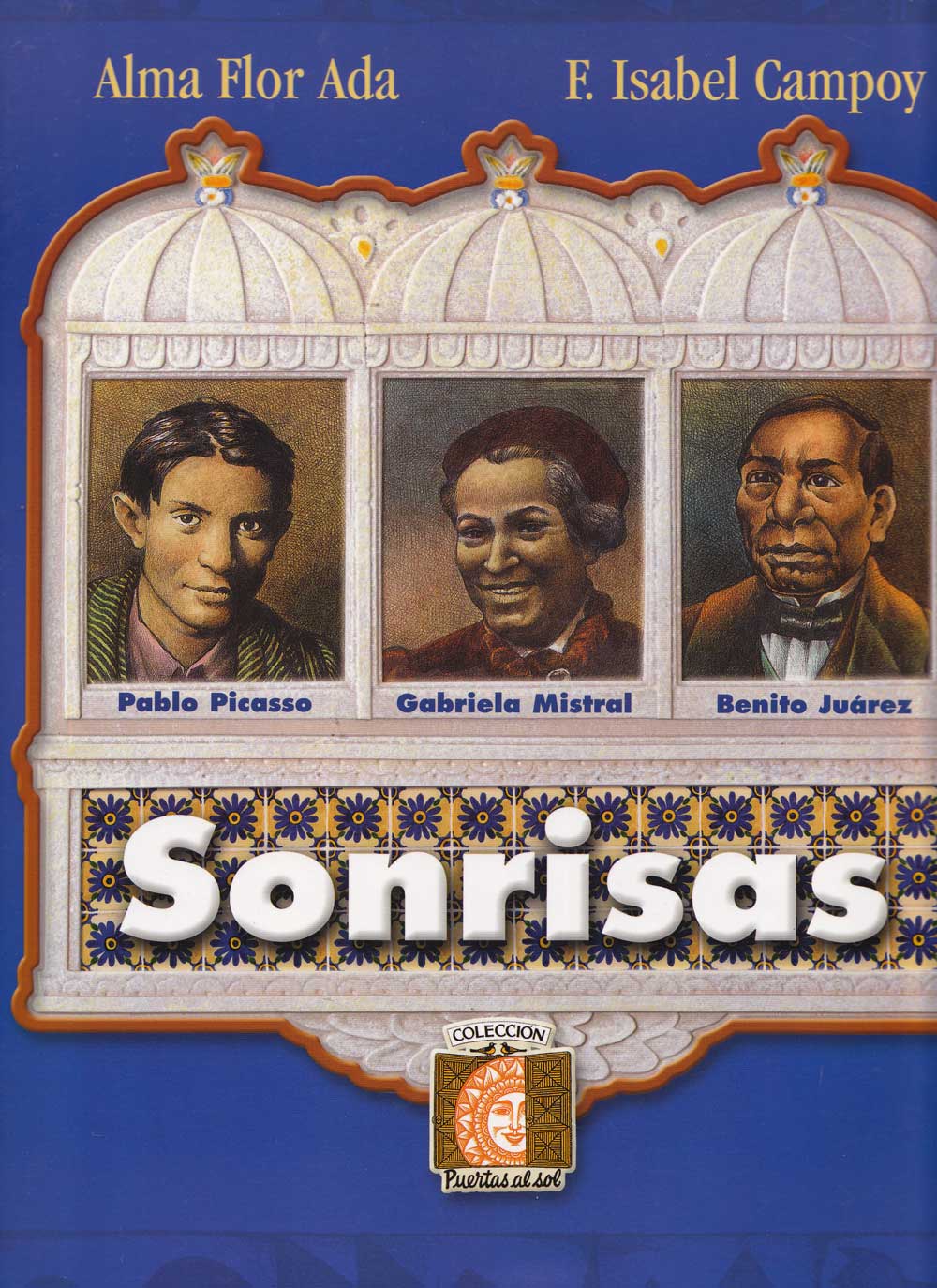
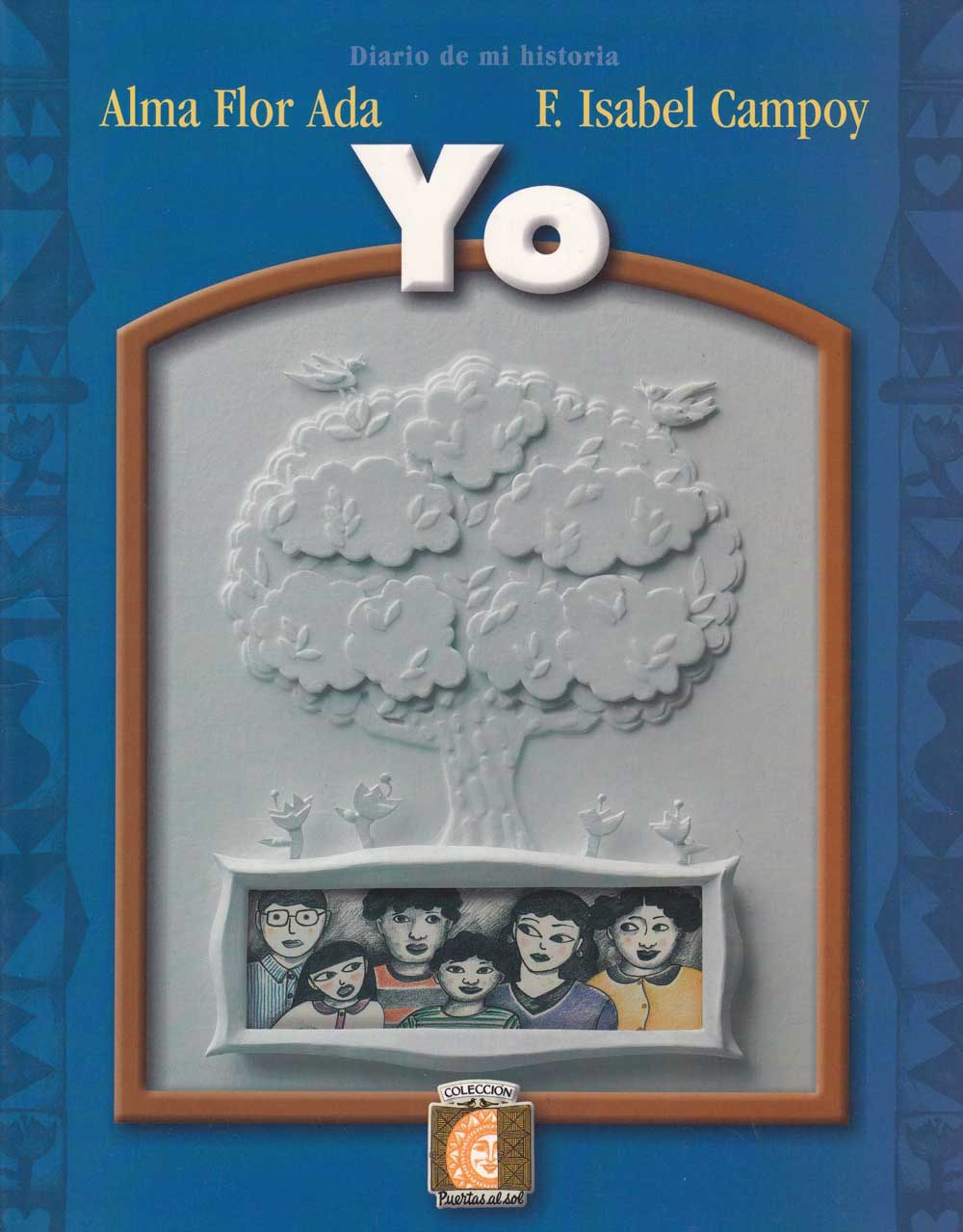 Sonrisas
/ Yo
Sonrisas
/ Yo
Smiles / I Am
Level 1 : Children recognize that they can change the world through innovation and fairness. In this light, they will appreciate art through the eyes of Pablo Picasso, poetry through the pen of Gabriela Mistral, and justice through the fortitude of Benito Juárez, while the journal allows students to develop their own autobiographical skills. Lesson Plan Worksheet
Listen to Vienna Rose read Smiles to you.
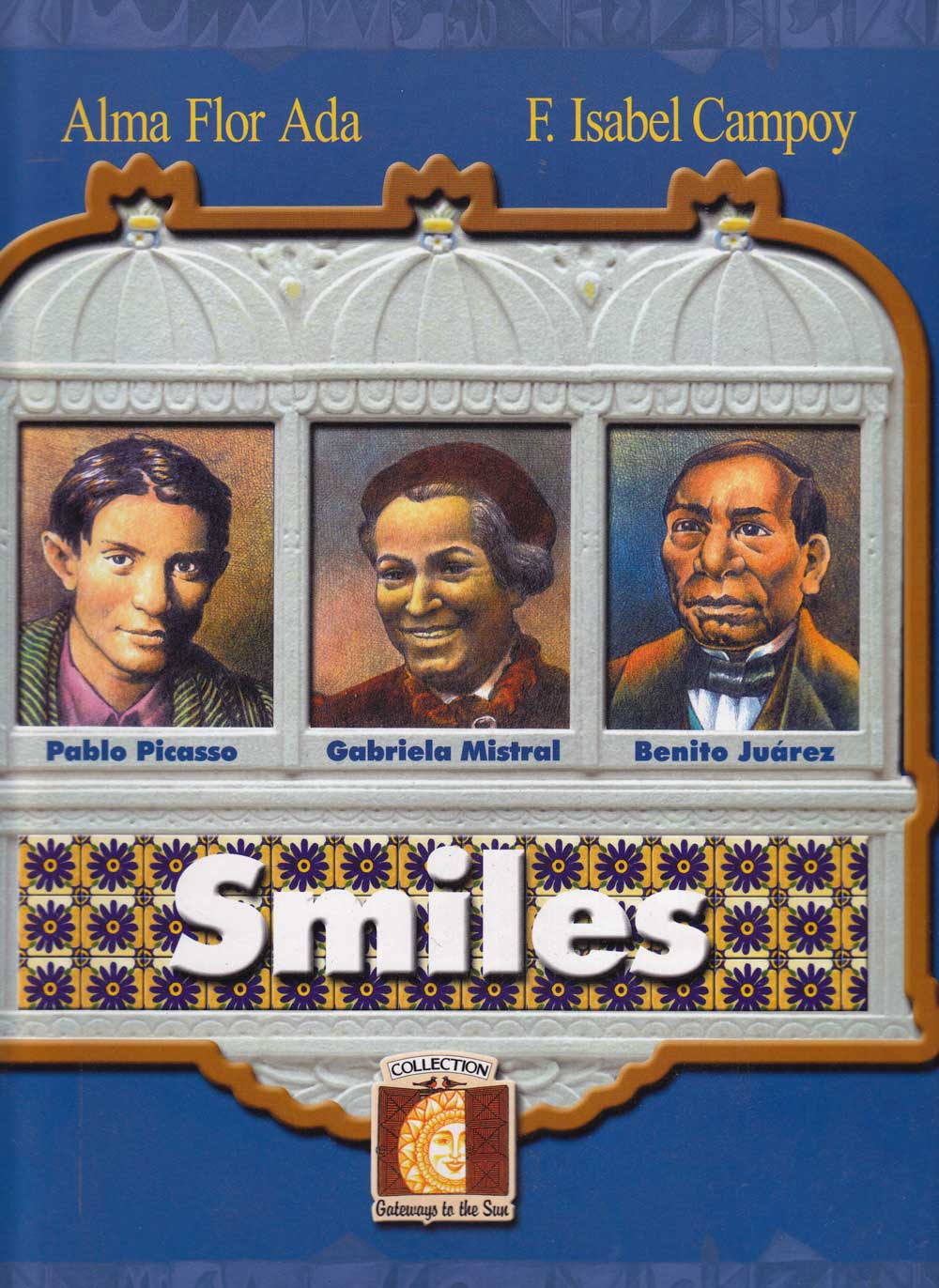
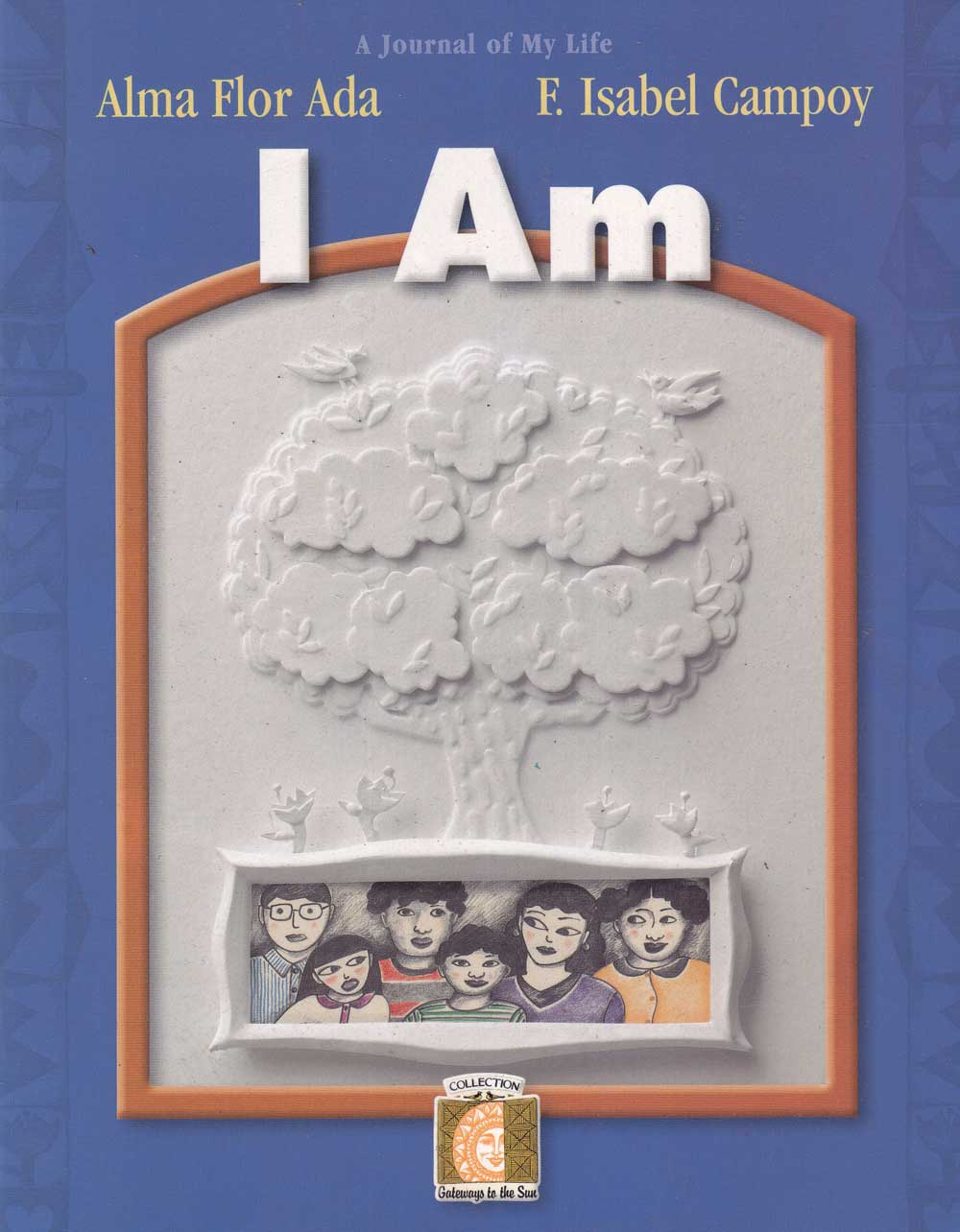
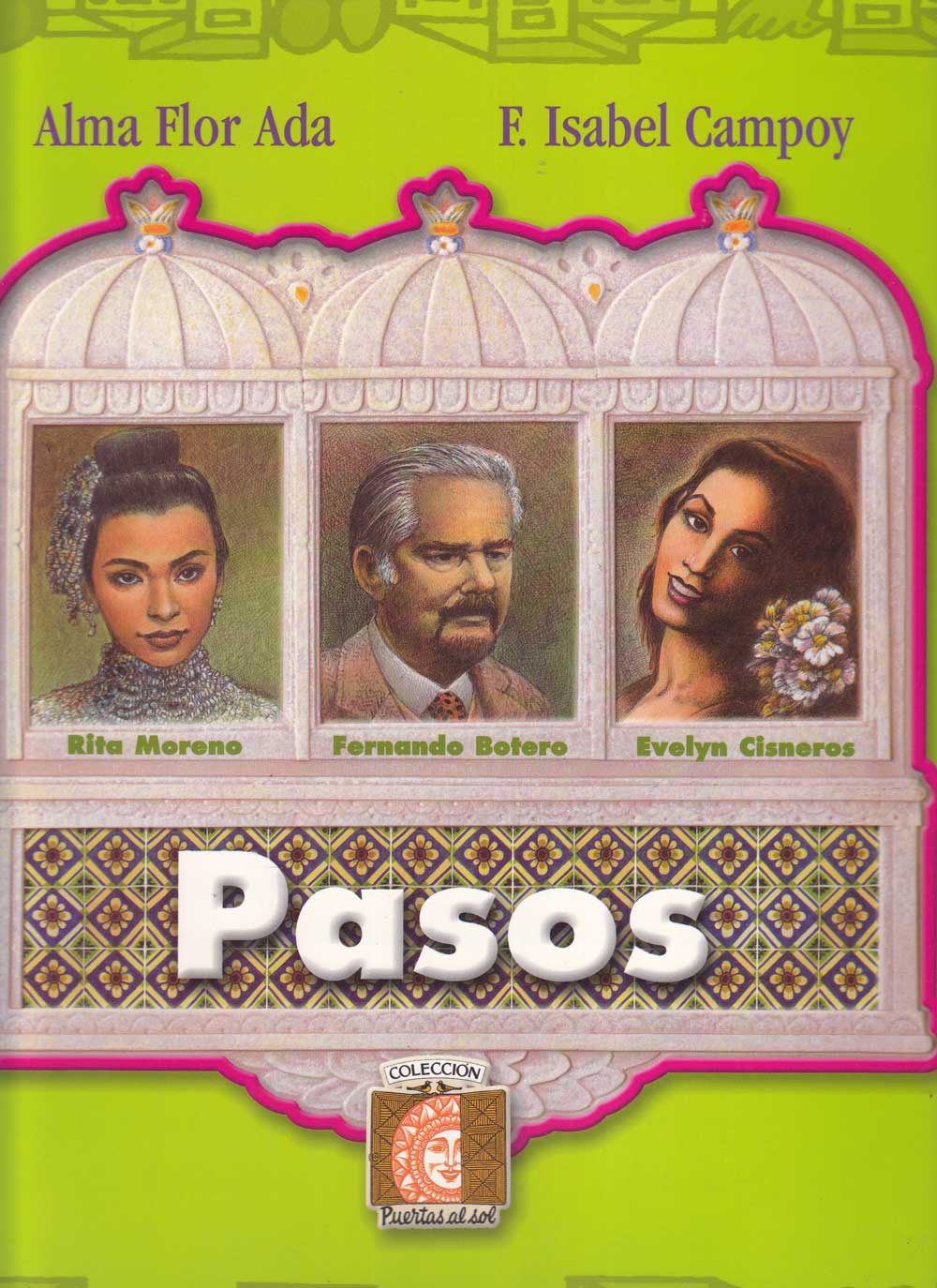
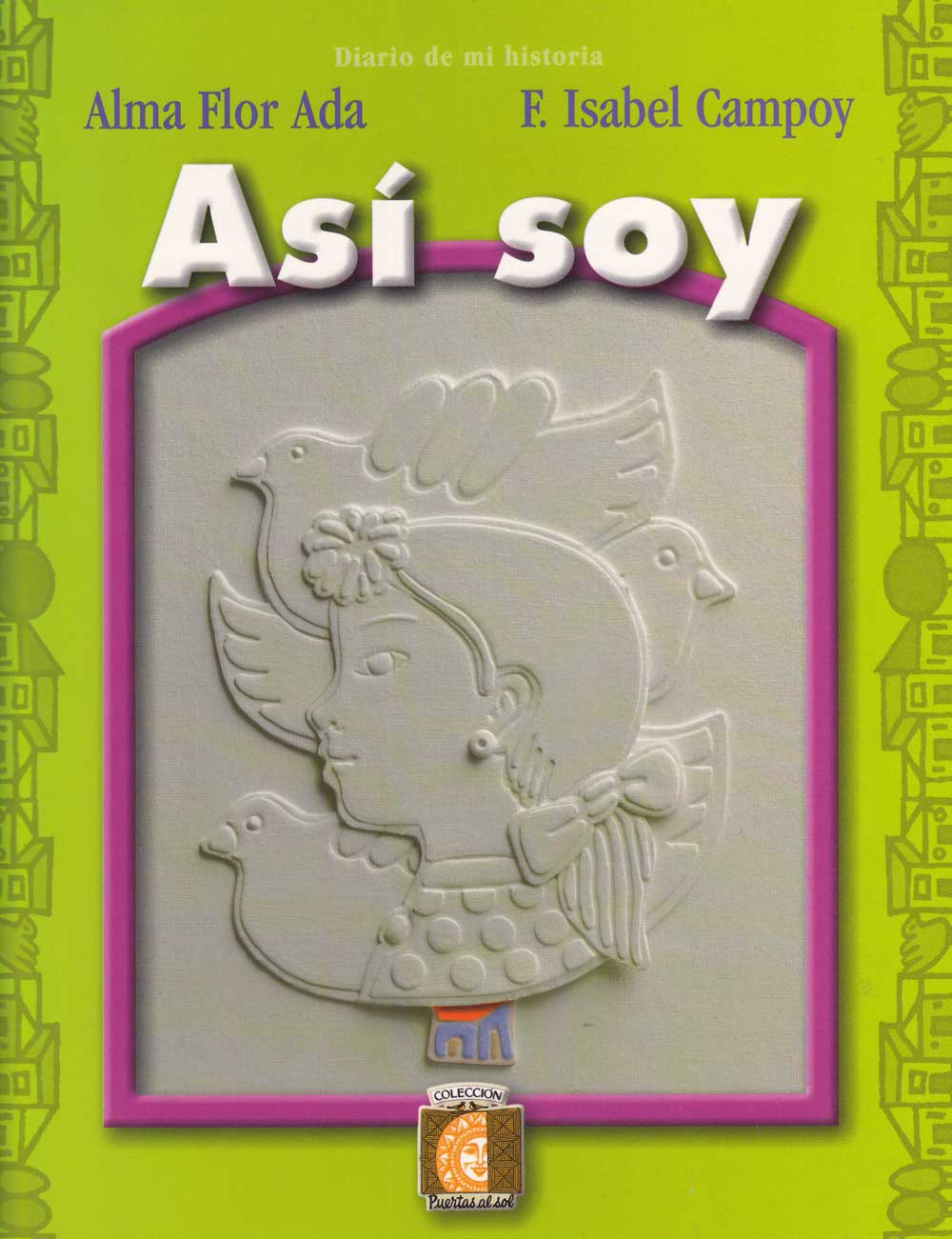 Pasos
/ Asi soy
Pasos
/ Asi soy
Steps
Level 2 : We all aspire to achieve fame, whether it be in the bright lights of Broadway, the magnificence of the Louvre, or on the spectacular stage of the San Francisco Ballet.Read about the famous lives of Oscar-, Emmy-, Grammy-, and Tony-award winning Rita Moreno, the unique artist Fernando Botero, and the elegant ballerina Evelyn Cisneros, while the journal allows students to develop their own autobiographical skills. Lesson Plan Worksheet
Listen to Vienna Rose read Steps to you.
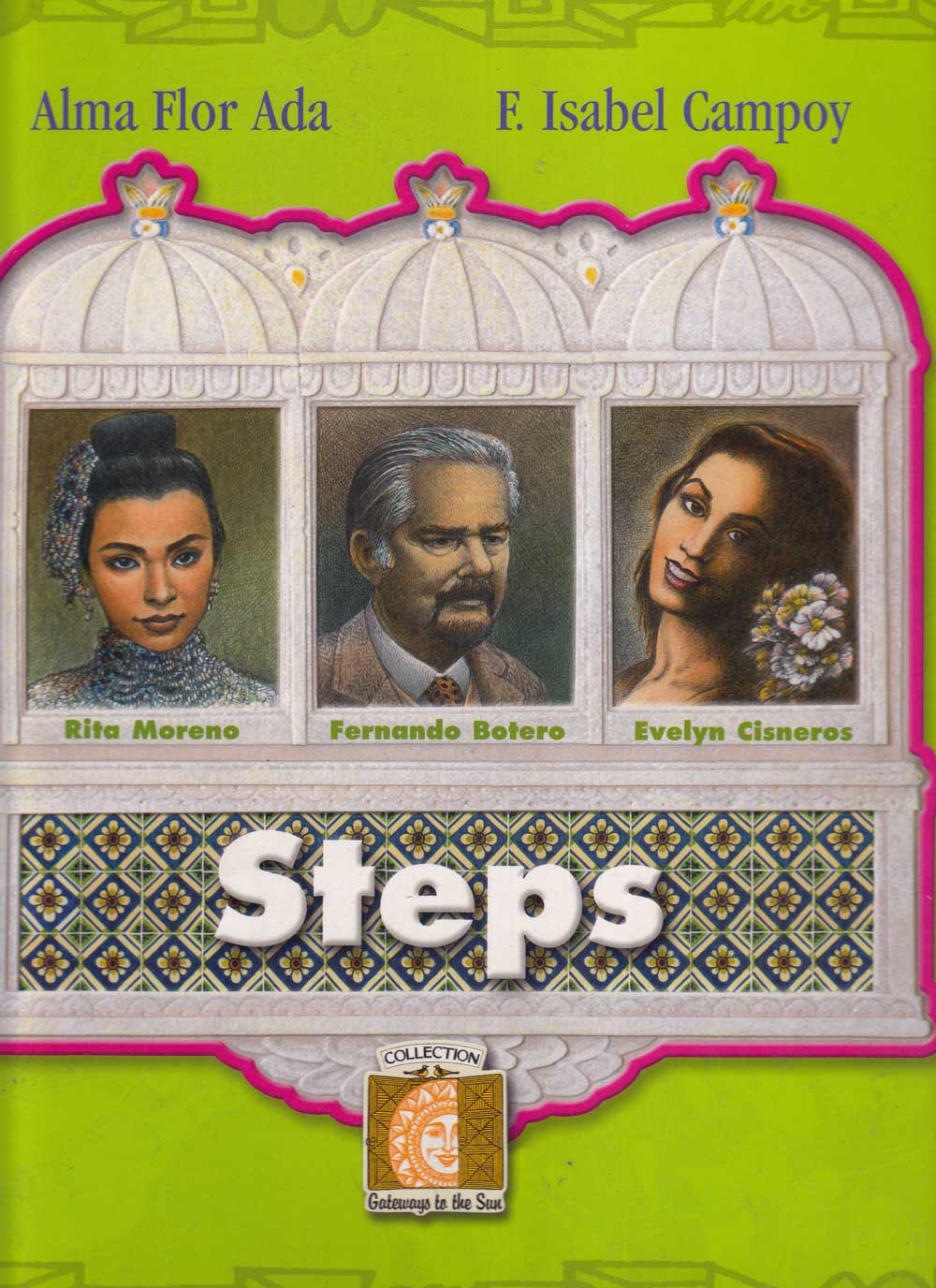
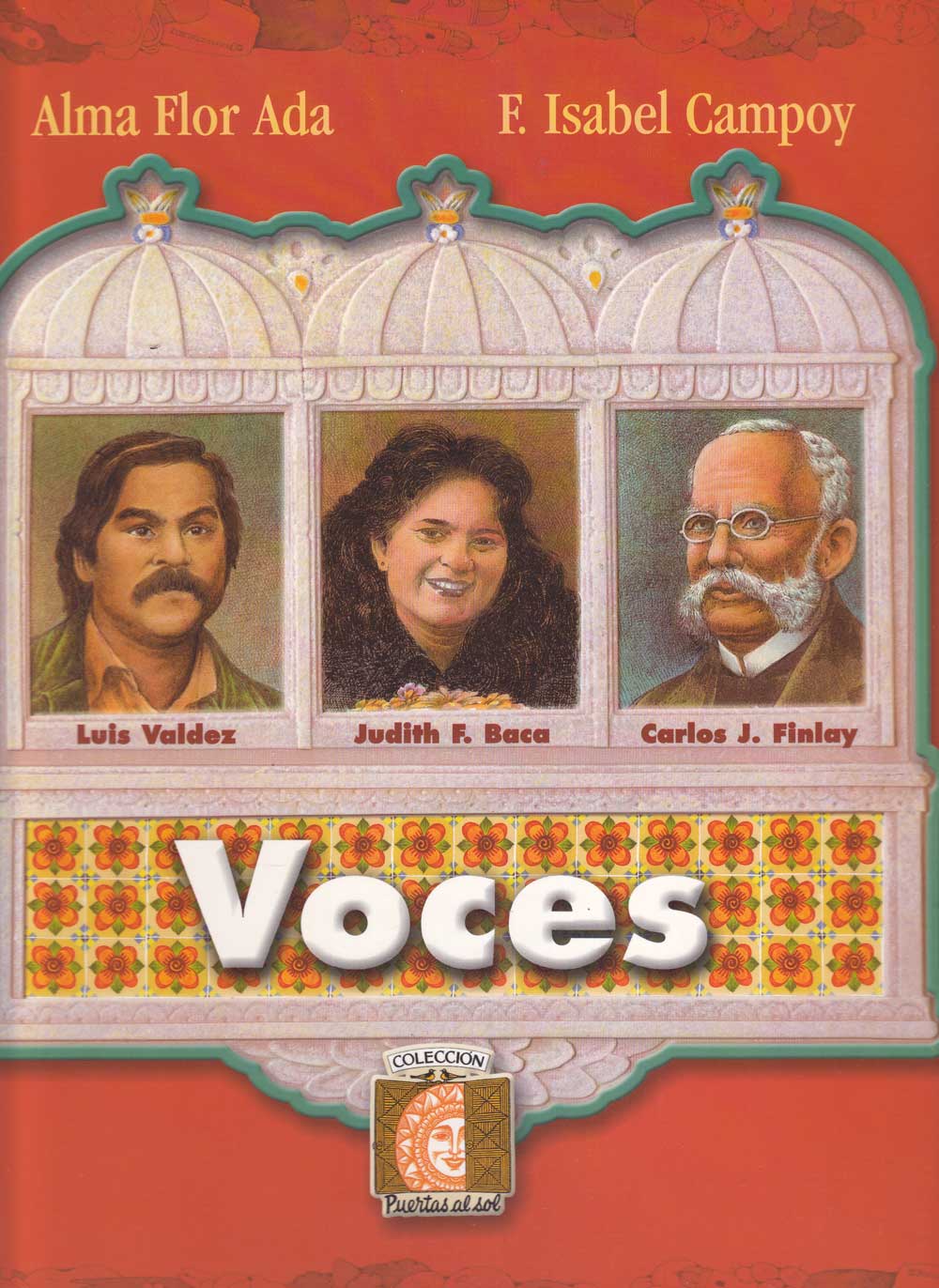
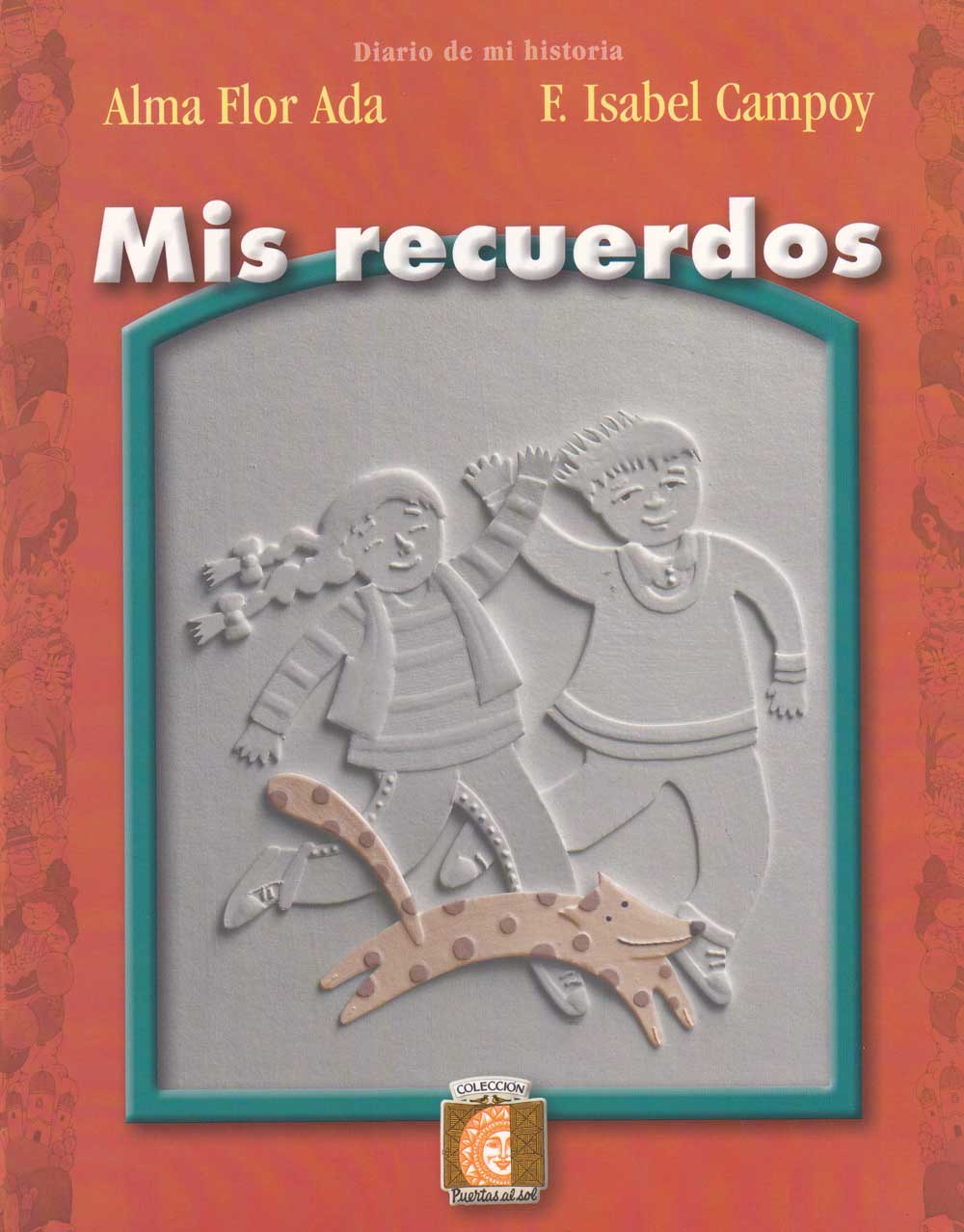 Voces
/ Mis recuerdos
Voces
/ Mis recuerdos
Voices / My Memories
Level 3 : Holding onto our dreams is one of the keys to success. Hop aboard as we accompany playwright, screenwriter, and director Luis Valdez, muralist Judith Francisca Baca, and the person who discovered the cause of yellow fever, Doctor Carlos Juan Finlay, from their humble beginnings to their incredible accomplishments, while the journal allows students to develop their own autobiographical skills.. Lesson Plan Worksheet
Listen to Vienna Rose read Voices to you.
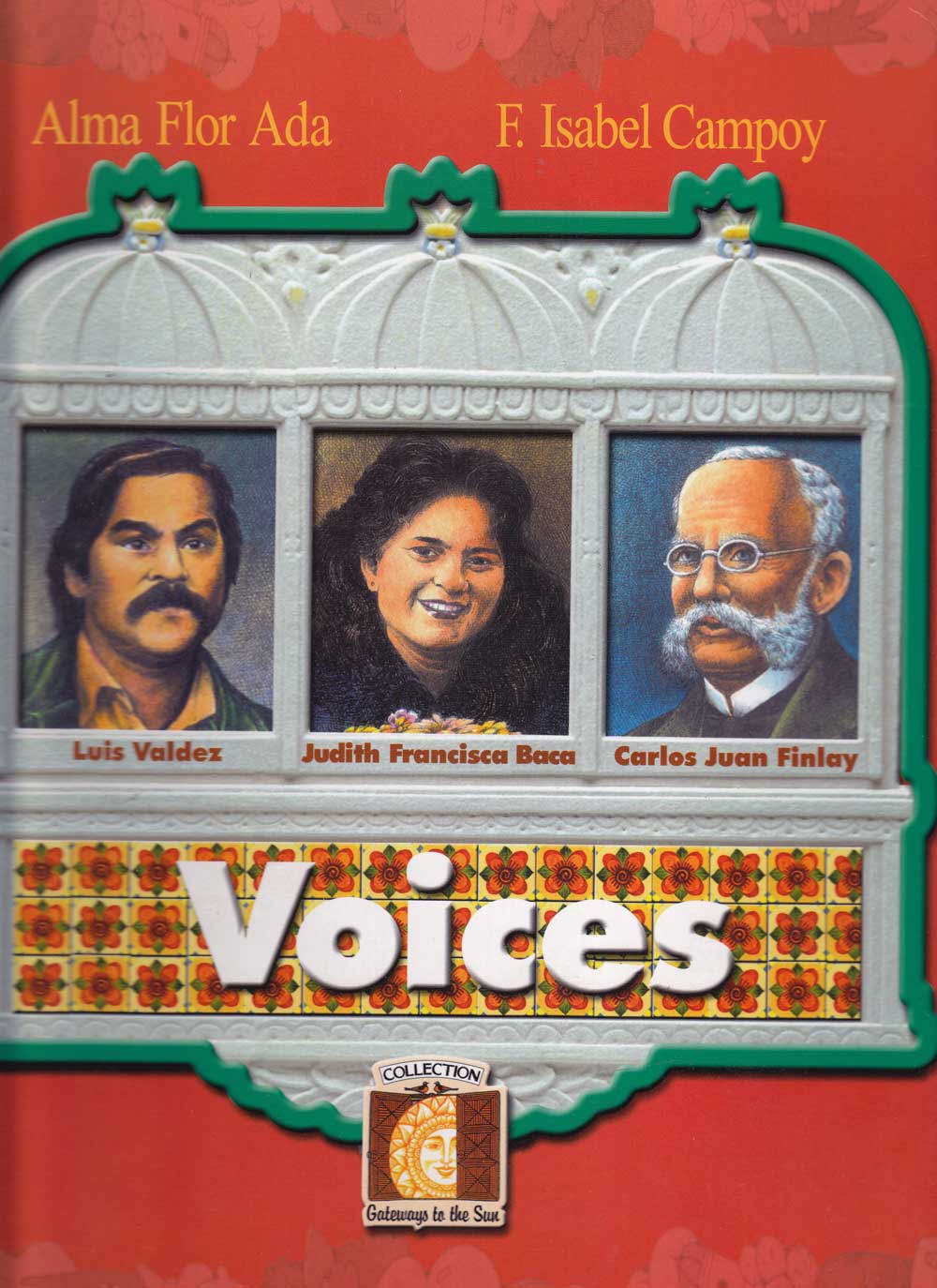
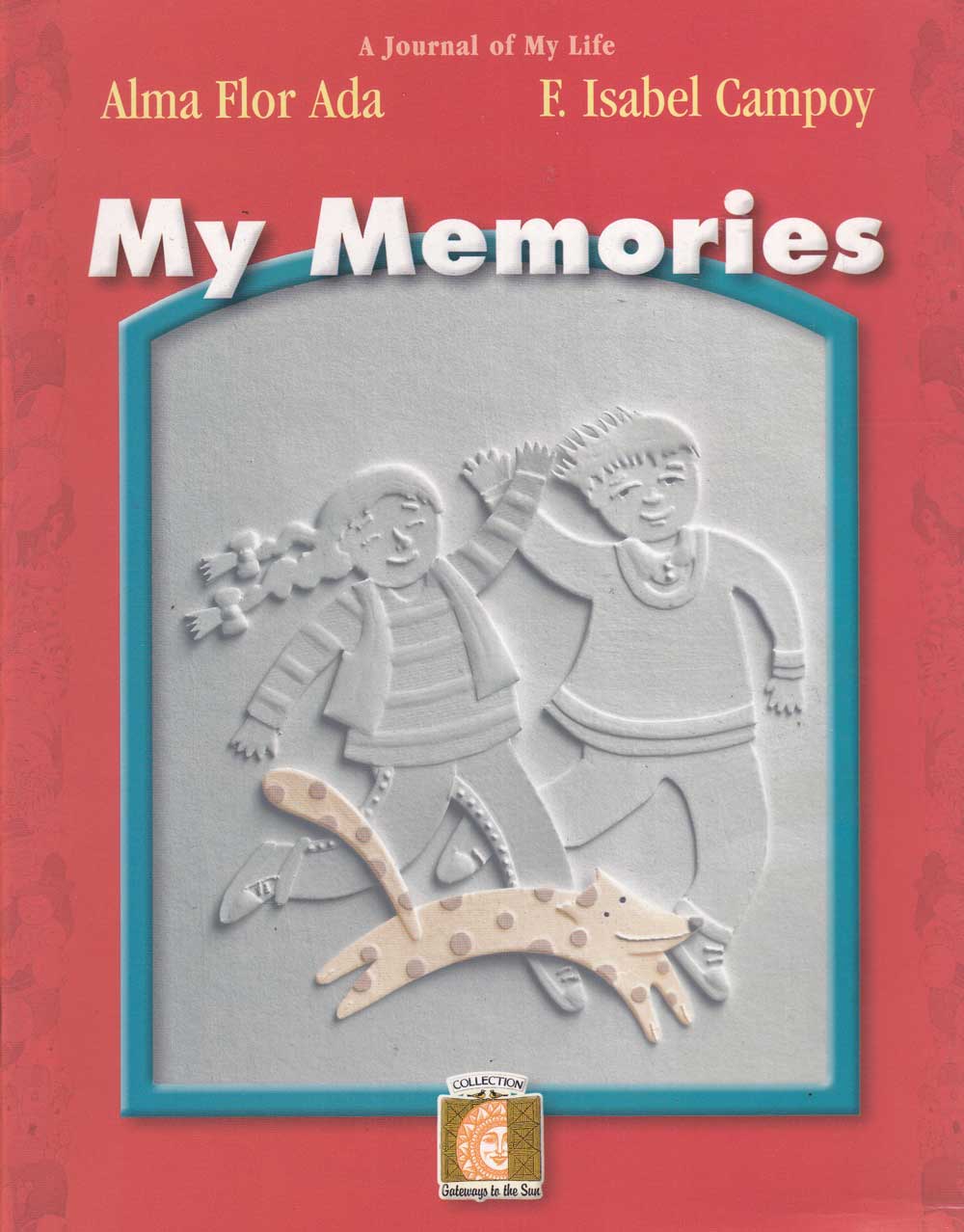

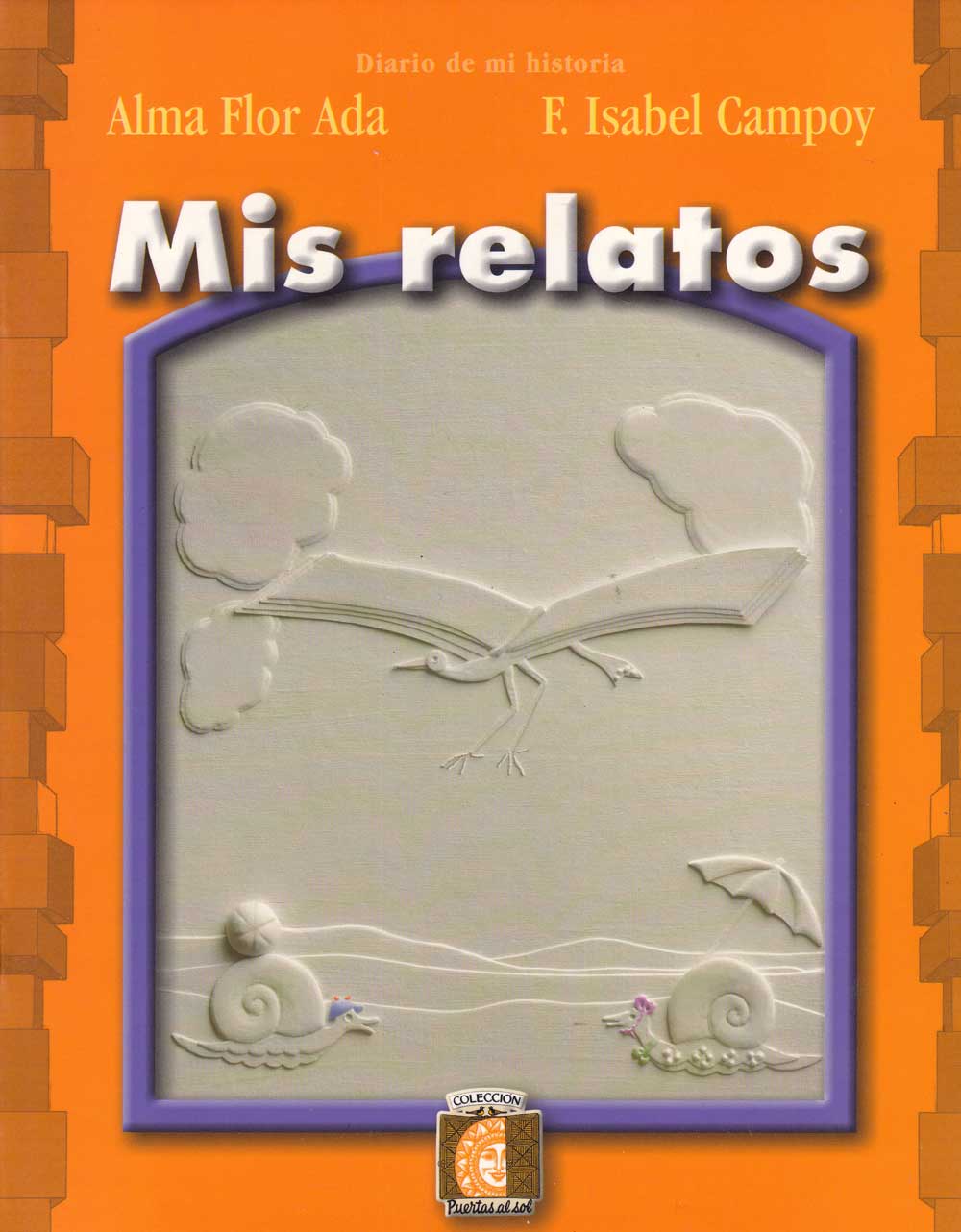 Caminos
/ Mis relatos
Caminos
/ Mis relatos
Paths
Level 4 : People who are dedicated to improving the lives of others possess special qualities. José Martí, Frida Kahlo, and César Chávez are three such people. Explore their lives and the way each one helped to change our world, while the journal allows students to develop their own autobiographical skills.. Lesson Plan Worksheet
Listen to Vienna Rose read Paths to you.
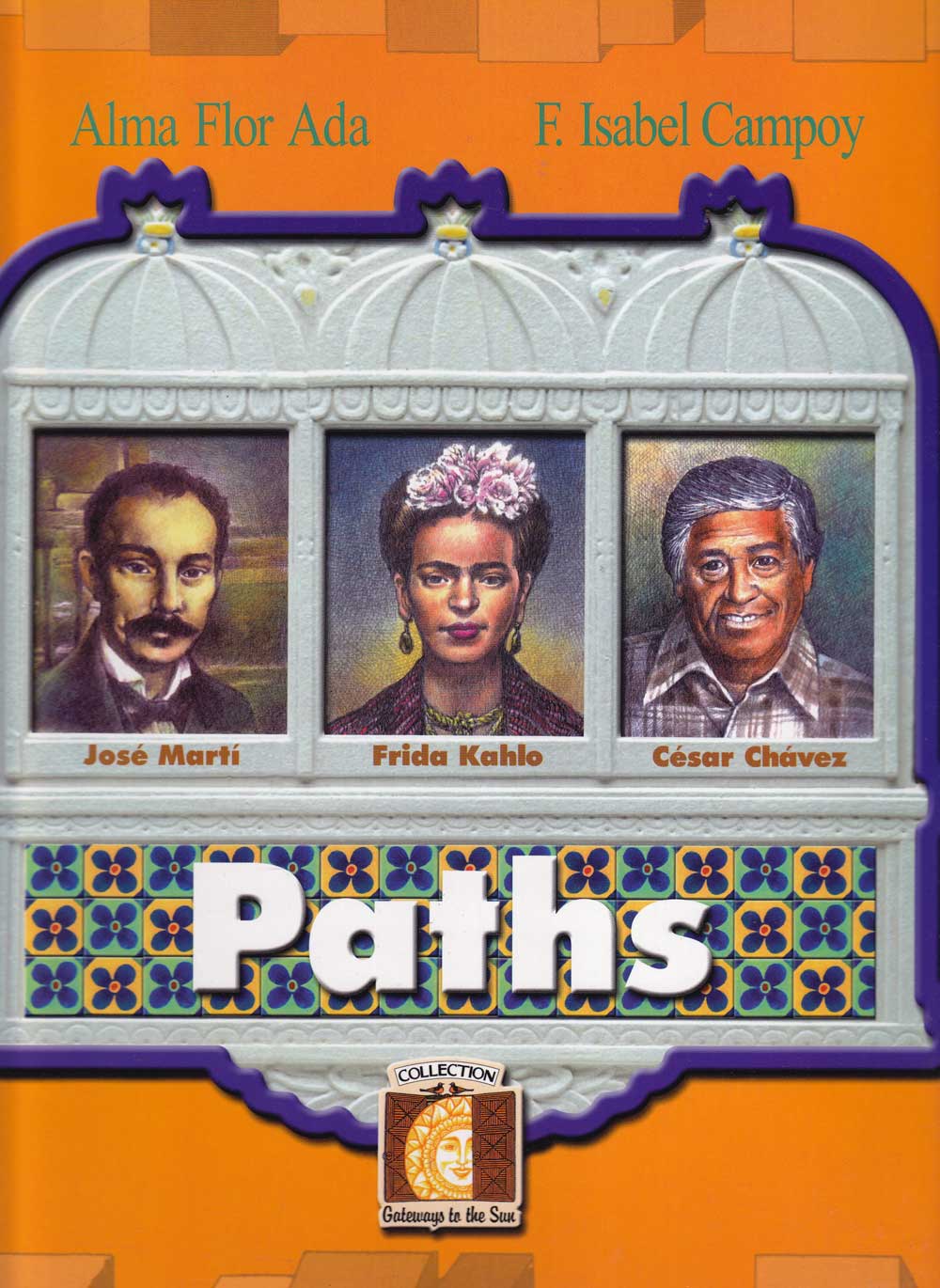
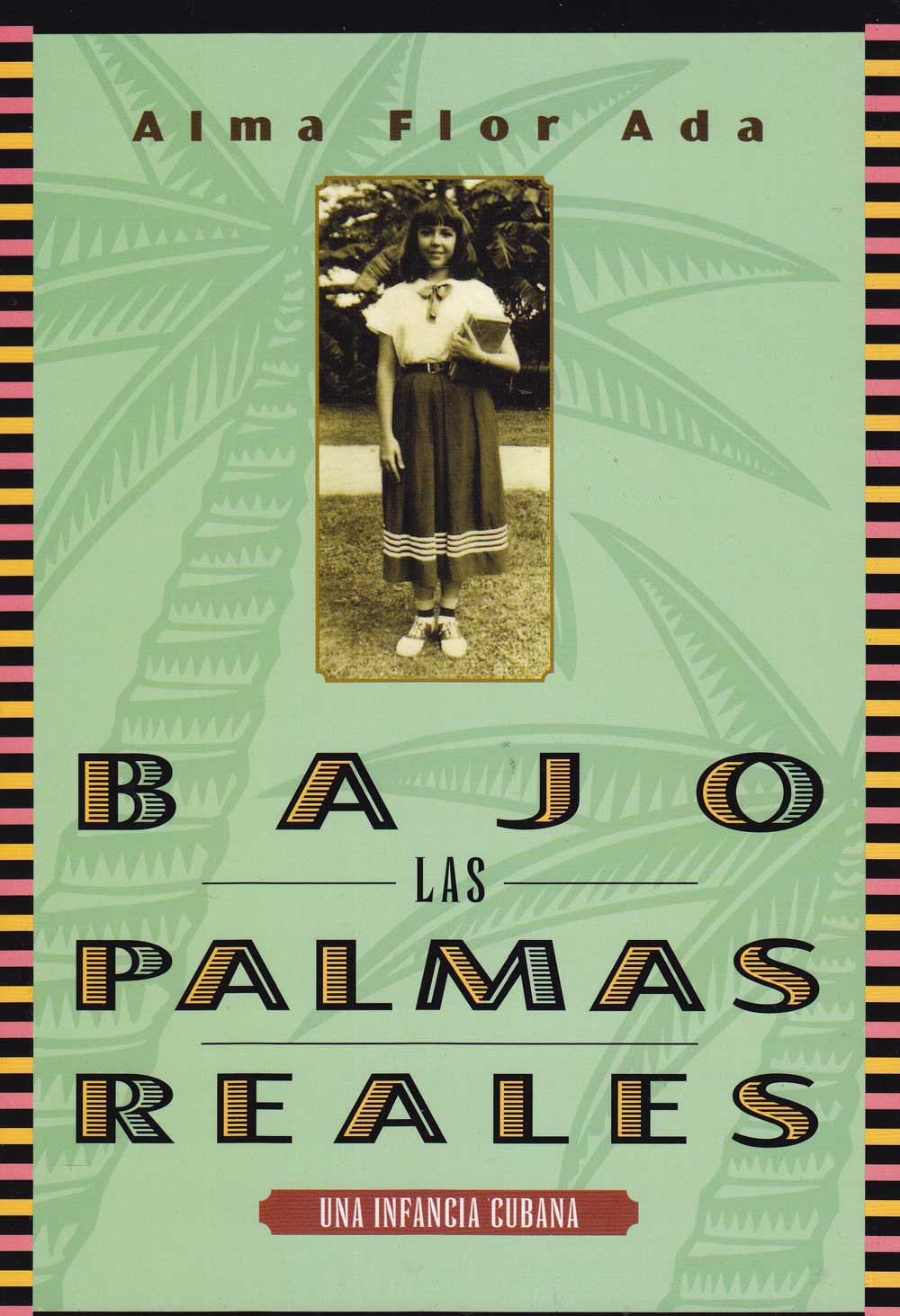 Bajo
las palmas reales
Bajo
las palmas reales
Under the Royal Palms
Pura Belpre Award
Winning Book in 2000 for Narrative
American Library Association, Best Books of the Year 2000
Center for Latin American Studies, America´s Commended List
National Council of Teachers of English, Notable Book in the Area of Language
Arts
Video : Colorin
Colorado Interview, Spanish
Video : Colorin
Colorado Interview, English
In this companion volume to Alma Flor Ada's "Where the Flame Trees Bloom", the author offers young readers another inspiring collection of stories and reminiscences drawn from her childhood on the island of Cuba. Through those stories we see how the many events and relationships she enjoyed helped shape who she is today. We learn of a deep friendship with a beloved dance teacher that helped sustain young Alma Flor through a miserable year in school. We meet relatives, like her mysterious Uncle Manolo, whose secret, she later learns, is that he dedicated his life to healing lepers. We share the tragedy of another uncle whose spirited personality leads to his love of flying...and the crash that takes his life. Heartwarming, poignant, and often humorous, this collection encourages children to discover the stories in their our own lives -- stories that can help inform their own values and celebrate the joys and struggles we all share no matter where or when we grew up.
The Pura Belpré Award honors Latino writers and illustrators whose work best portrays, affirms and celebrates the Latino cultural experience in a children's book. Alma Flor Ada was named the winner of the Belpré Author Award for Under the Royal Palms: A Childhood in Cuba, published by Atheneum Books. The award was announced January 17, 2000 during the American Library Association (ALA) Midwinter Meeting in San Antonio. The award is administered by the Association for Library Service to Children (ALSC), a division of ALA, and REFORMA, the National Association to Promote Library Services to the Spanish Speaking.
Listen to Vienna Rose read Under the Royal Palms to you. A marvelous example of the magical encounter between a child and books that we wish for all children. And here's an earlier reading by Vienna Rose.
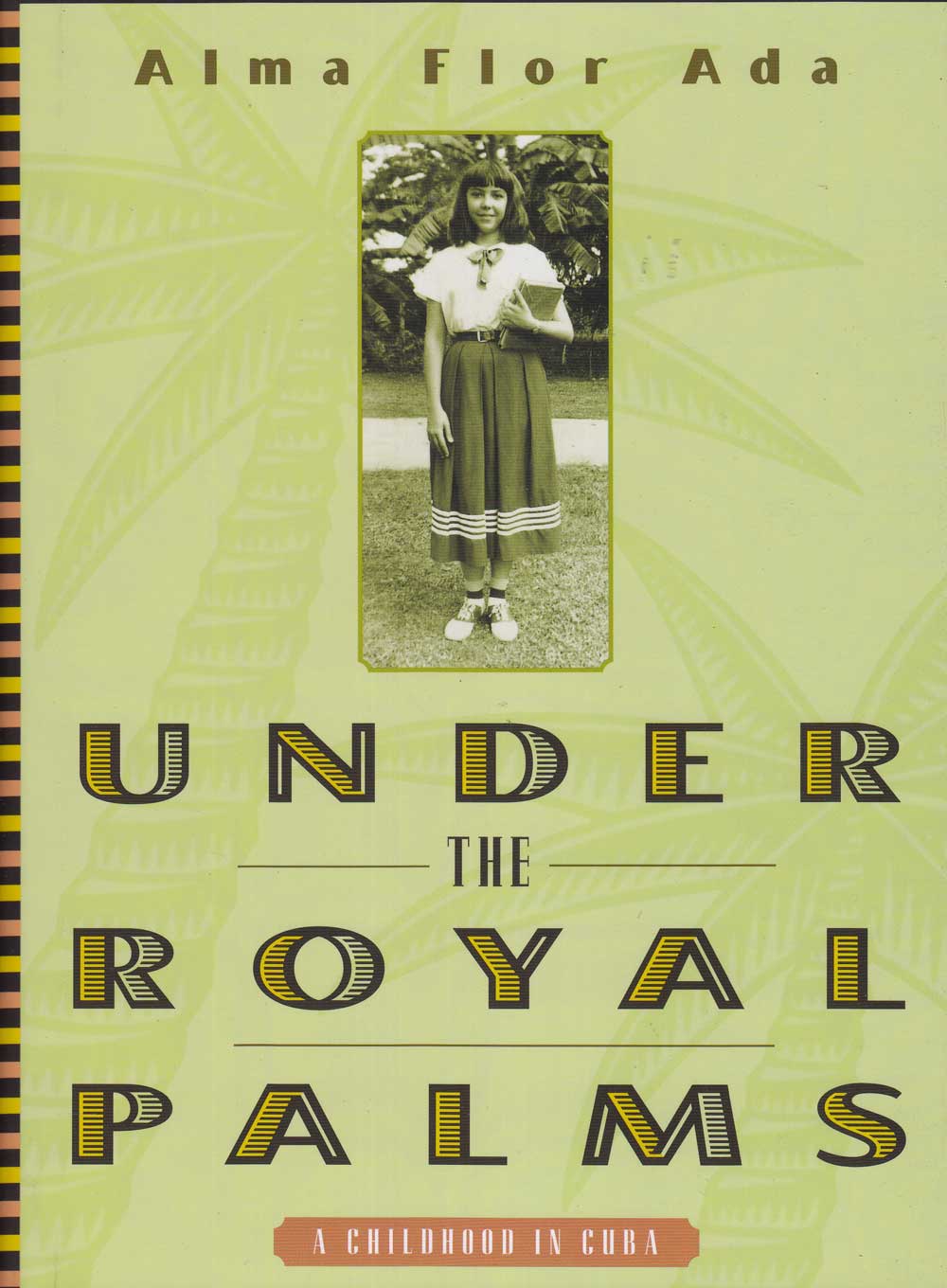 Powells : In this
companion volume to Alma Flor Ada's Where the Flame Trees Bloom, the
author offers young readers another inspiring collection of stories and
reminiscences drawn from her childhood on the island of Cuba. Through those
stories we see how the many events and relationships she enjoyed helped shape
who she is today. We learn of a deep friendship with a beloved dance
teacher that helped sustain young Alma Flor through a miserable year in
school. We meet relatives, like her mysterious Uncle Manolo, whose secret, she
later learns, is that he dedicated his life to healing lepers. We share the
tragedy of another uncle whose spirited personality leads to his love of
flying...and the crash that takes his life. Heartwarming, poignant, and
often humorous, this collection encourages children to discover the stories in
their our own lives — stories that can help inform their own values and
celebrate the joys and struggles we all share no matter where or when we grew
up. Synopsis : The
author recalls her life and impressions growing up in Cuba. In
this companion volume to Alma Flor Ada's Where the Flame Trees Bloom, the
author offers young readers another inspiring collection of stories and
reminiscences drawn from her childhood on the island of Cuba. Through those
stories we see how the many events and relationships she enjoyed helped shape
who she is today. We learn of a deep friendship with a beloved dance
teacher that helped sustain young Alma Flor through a miserable year in
school. We meet relatives, like her mysterious Uncle Manolo, whose secret, she
later learns, is that he dedicated his life to healing lepers. We share the
tragedy of another uncle whose spirited personality leads to his love of
flying...and the crash that takes his life. Heartwarming, poignant, and
often humorous, this collection encourages children to discover the stories in
their our own lives — stories that can help inform their own values and
celebrate the joys and struggles we all share no matter where or when we grew
up.
Powells : In this
companion volume to Alma Flor Ada's Where the Flame Trees Bloom, the
author offers young readers another inspiring collection of stories and
reminiscences drawn from her childhood on the island of Cuba. Through those
stories we see how the many events and relationships she enjoyed helped shape
who she is today. We learn of a deep friendship with a beloved dance
teacher that helped sustain young Alma Flor through a miserable year in
school. We meet relatives, like her mysterious Uncle Manolo, whose secret, she
later learns, is that he dedicated his life to healing lepers. We share the
tragedy of another uncle whose spirited personality leads to his love of
flying...and the crash that takes his life. Heartwarming, poignant, and
often humorous, this collection encourages children to discover the stories in
their our own lives — stories that can help inform their own values and
celebrate the joys and struggles we all share no matter where or when we grew
up. Synopsis : The
author recalls her life and impressions growing up in Cuba. In
this companion volume to Alma Flor Ada's Where the Flame Trees Bloom, the
author offers young readers another inspiring collection of stories and
reminiscences drawn from her childhood on the island of Cuba. Through those
stories we see how the many events and relationships she enjoyed helped shape
who she is today. We learn of a deep friendship with a beloved dance
teacher that helped sustain young Alma Flor through a miserable year in
school. We meet relatives, like her mysterious Uncle Manolo, whose secret, she
later learns, is that he dedicated his life to healing lepers. We share the
tragedy of another uncle whose spirited personality leads to his love of
flying...and the crash that takes his life. Heartwarming, poignant, and
often humorous, this collection encourages children to discover the stories in
their our own lives — stories that can help inform their own values and
celebrate the joys and struggles we all share no matter where or when we grew
up.
Publishers Weekly :
In this handsomely designed companion volume to Where the Flame Trees Bloom, Ada
once again draws upon her experiences growing up in post-war Cuba. In a short
introduction, the author describes her hometown, Camaguey, as a "city of
contrasts" diverse religions and education and economic levels ("some
had so much and others had very little"). The 10 stories that follow do not
focus on these oppositions so much as the unique experiences of young Alma and
her extended family. Several memories poignantly expose the disparity between
those who have and those who have not, such as "Explorers," in which
young Alma and her cousin get lost in a marabu field and are aided and fed by a
poverty-stricken family. Others illustrate life lessons (for example, the
impossible but gleeful task of counting bats in flight for their nightly feeding
taught Alma to appreciate the process of an endeavor, rather than its
completion). But the best of these stories simply recreate a poignant or
humorous moment from the author's girlhood: Alma sipping from a porron (a small
clay pot) at school, lovingly filled with water by her mother; Alma's pride in
her uncle's daring turning to grief when he dies in an airplane crash. Many of
the stories stand well alone, but some take a meandering expository path to
recount a history or explain a term. These more formal (though often graceful)
tangents distance readers from the slices of life. Still, at the core of the
collection, there is a heartfelt portrayal of a quickly disappearing culture and
a vastly beautiful land. Ages 8-12.
School Library Journal : Grade 4-7-This simple and graceful reminiscence of a
childhood in Cuba in the 1940s is a companion to Where the Flame Trees Bloom (Atheneum,
1994). Although not wealthy, the author's family lived comfortably with aunts,
uncles, and cousins in a large, shared family home in the small town of Camaguey.
Here any event beyond the ordinary became the focus of everyone's attention and
the fuel for many days of conversation. Each chapter includes an early memory or
experience of Ada's: nursing the baby bats that fell onto her porch, the
production of simple and inexpensive plaster figures for nativity scenes, etc.
The author writes about the contrast of wealth and poverty in her country at
that time and of the people who made an impression on her, including a ballet
teacher who befriended her during a lonely year in a new school, and an uncle
and aunt who worked with lepers. Her observations of people lead to a series of
revelations that shaped her life. Black-and-white photographs of the author and
her family appear throughout.
The New York Times
Book Review : The success of ''Under the Royal Palms: A Childhood in Cuba,'' the
companion volume to Alma Flor Ada's ''Where the Flame Trees Bloom,'' derives in
no small part from its appeal to adults as well as children. The author, a
professor of multicultural education at the University of San Francisco who has
written a number of children's books, understands that to get to a child's
bedroom shelves, often a book must first enchant choosy adults to buy it. And
enchant this one does. The slim, handsome book is divided into 10
chapters, each a self-contained story about Ada's childhood half a century ago
in Camaguey, a city in the province of the same name in the center of Cuba,
known as the cradle of great poets and courageous freedom fighters. The stories
and the endearing black-and-white photographs of her family are woven into a
greater theme: everything Ada learned about life, she explains, she learned in
her small town, surrounded by family and nature. Although this feels preachy at
times, most parents would surely not mind the lessons. For instance, after
telling how she spent childhood evenings trying to count bats with her loving
grandmother, she draws an eminently sensible conclusion that could easily be
applied to many an apparently vain effort: ''On the many occasions when I have
later felt that I am once more trying to count bats, engaged in an impossible
task, I have allowed myself to laugh, happy to remember that some of the best
things in life are like counting bats: it was never the final count that
mattered, but rather the joy of seeing them fly.''
Kirkus Reviews : Of books comprising nuggets of memory there seems to be no end,
and in a companion volume to her Where the Flame Trees Bloom (1994, not
reviewed), Ada recounts small stories of growing up in the town of in Camagey,
Cuba. She captures with some feeling the powerful effect of scent on memory:
night jasmine, coffee, ylang-ylang, and her grandmother's perfume of lavender
and sage. She immortalizes sibling hurts and uncles' gifts, and writes of the
childhood mystery of adult conversations partially overheard and partially
understood. She is rich in family, attempting with her grandmother the
impossible task of counting bats as they fly, and smashing her favorite doll
when her dashing uncle dies in a plane crash. She is rich in memories of other
adults, too: Madame Marie, a French-Jewish refugee; Gilda, a dance teacher,
whose affection carried Ada through an impossible year at school. Some
repetition does not detract, and children might be moved by Ada's exhortation to
consider their own family stories.
CLASP : Alma Flor Ada offers stories about Cuba that would not otherwise be available to those of us living in the United States. This collection provides the reader with a close look at an active and loving extended family. It chronicles events that would probably stand out for lots of children growing up throughout history and across geographical boundaries: living in different houses, in the city and in the country... and the tragic death of a beloved young uncle. This volume provides information on a prolific author that is accessible and helpful to readers studying Latino writers."
Booktalks : Who knows where Cuba is? Alma Flor Ada takes us to Cuba and describes her memories as a little girl there. You will feel like you are right there feeling everything she is. As you read you will be able to see the photos of her family and friends which make it come to life even more. We all have fun times in our lives and we also have tragedies happen. Alma Flor Ada describes her Uncle's plane crash and I thought I was right there. To see what Cuba is like and Alma's memories of her childhood you must read "Under the Royal Palms" by Alma Flor Ada.
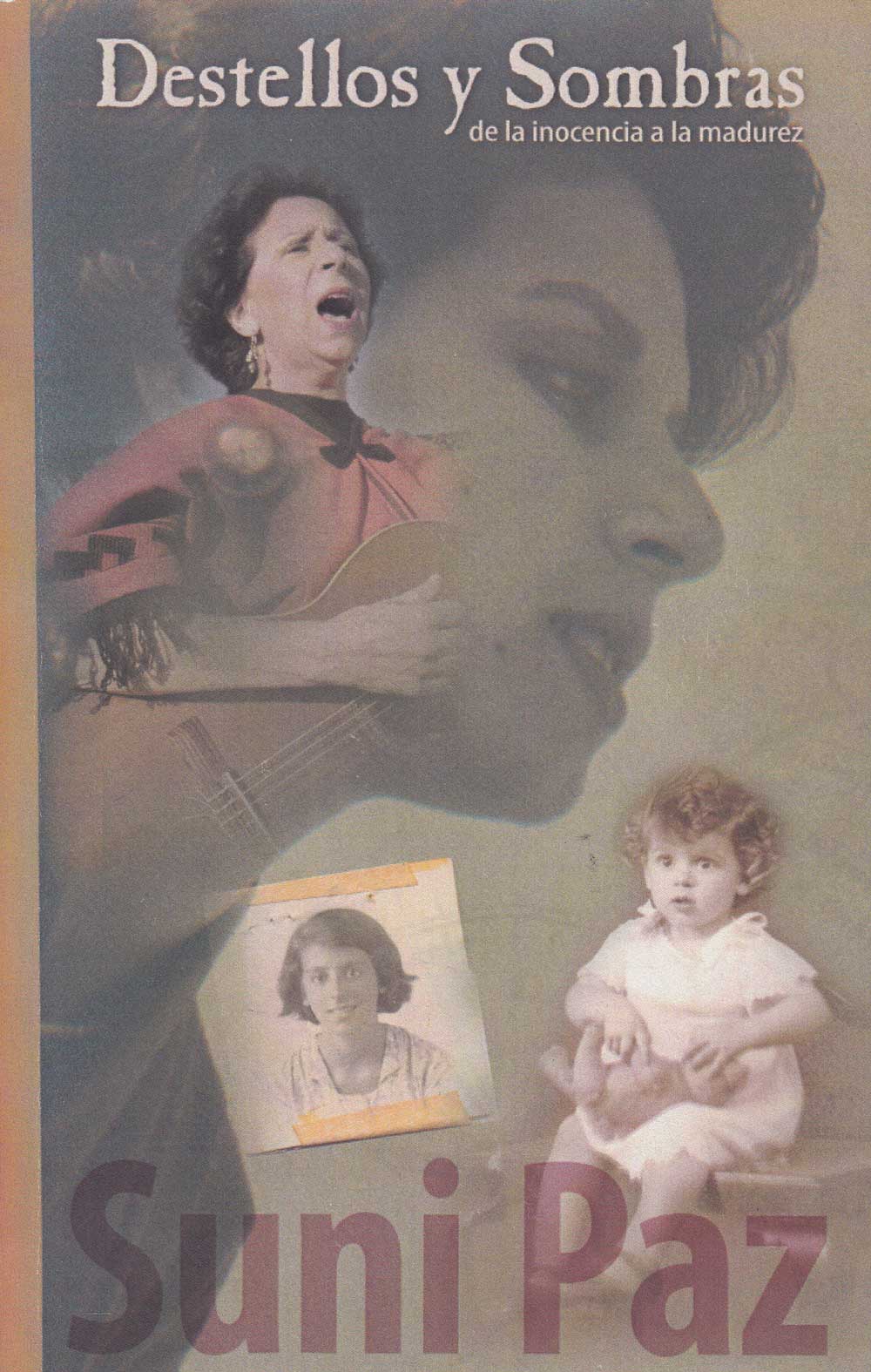 Destellos
y Sombras
Destellos
y Sombras
Sparkles and Shadows
Author's Note : This book is a memoir written with anecdotes. It is the saga of an Italian-Argentine family, the Calandrelli family. They gave birth to talented, original people whose works became published, printed, played and recognized in Argentina, in Europe and in the United States. Their lives were lived in Buenos Aires, a bustling city even in the 1900, but with mores, beliefs and happenings that move from the innocent, to the humorous, to the terrifying. Throughout the book runs a thread of love and understanding of the values and prejudices of the times. Of this book, it was said: “Here, early encounters with prejudice are recounted with unflinching honesty and tales of immigration told with such timeless tenderness and thoughtful insight that they remain fully relevant to today’s world.” Among the characters in the book we find an aunt that makes magic, is a writer, a graphologist, an amateur astronomist and becomes a celebrated poet writing in French and in Spanish; an uncle who is a pianist and an inventor; a grandfather that is a well-known doctor, a musician, and a poet; a grandma, an artist, not an architect, that makes blue prints for a house she is set to build in the middle of nowhere; a mother that in her deathbed sees Death entering through a balcony, and a four-year-old musical genius that ends up in the United States with 25 Grammy nominations, two Grammys won, and two Oscars. Finally, the author of Sparkles and Shadows is the recipient of several awards, a performing artist, a singer and a songwriter with more than four hundred recorded songs. To make this saga more real, today, in the hills of Rome, in the Trastevere, one can see busts of members of the Calandrelli family with a nearby street named after them: Via Calandrelli. I, personally, must add that I wanted my children to know what kind of family they came from, what heritage they had behind, the makings of their DNA. Today, too many children have no roots, no relatives around that can remind them of who they are. With no known heritage behind, children look for a place to belong to, usually gangs or drugs. If we want strong families, strong children, that is, strong “trees,” we need to give them strong “roots.” A way to do that is by telling them the story of their families and when possible, keep alive their language and their culture.
Listen to Vienna Rose read Sparkles and Shadows to you. A marvelous example of the magical encounter between a child and books that we wish for all children.
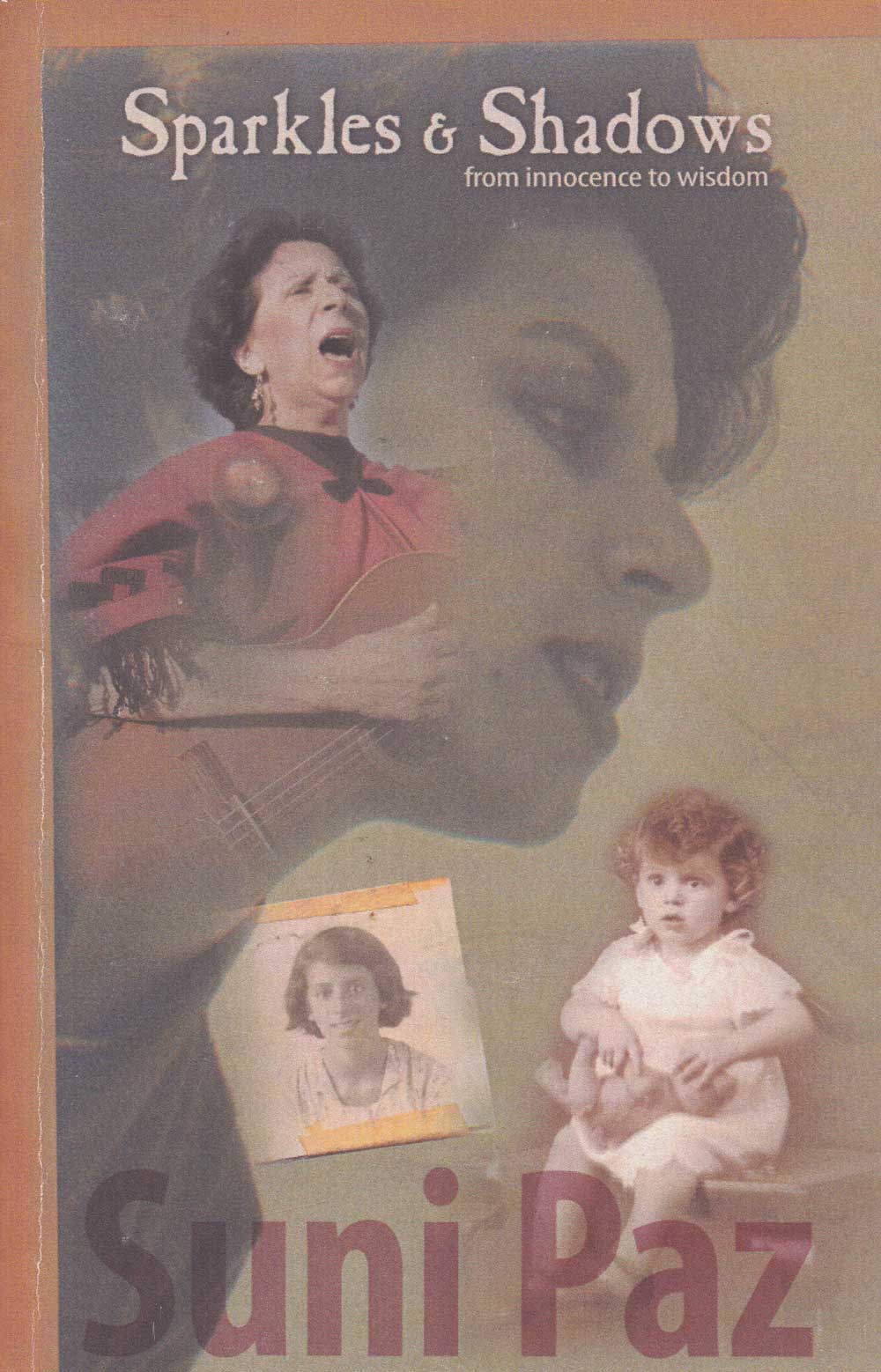 Early encounters
with prejudice and tales of immigration are told with unflinching honesty and
with such untimeless tenderness and thoughtful insight that they remain fully
relevant to our current curcumstances. Throughout this memoir, exposure to
European culture never overshadows the powerful influence of folklore and the
Argentine avant garde on the artist's childhood. - Lisa Stewart Garrison
Early encounters
with prejudice and tales of immigration are told with unflinching honesty and
with such untimeless tenderness and thoughtful insight that they remain fully
relevant to our current curcumstances. Throughout this memoir, exposure to
European culture never overshadows the powerful influence of folklore and the
Argentine avant garde on the artist's childhood. - Lisa Stewart Garrison
Enchanted and profound, this book invites the reader to take part in the intimate experiences of the author. What makes her stories unfortgettable is the authenticity of the voice and the cadence of her word. A book to be treasured. - Dr. Alma Flor Ada
This author submerges us in a pleasant voyage of discovery of the intimate, fragile, and subtle of the human experience. Then, she invites our hearts to a big laugh by introducing us to situations unthinkable in 20th Century Argentina. Suni Paz offers these flowers of her passion to our enjoyment and, surprisingly, to our reflection. A magnificent book! - F. Isabel Campoy
How good to find once in a while such a special book. After reading many autobiographical stories Suni's appeared, filled with a million histories, told with clear and involving language. Her work reunites the indispensable prerequisites to a good reading and transports us to our own history. - Clarita Kohen Klieman
“Here, early
encounters with prejudice are recounted with unflinching honesty and tales of
immigration told with such timeless tenderness and thoughtful insight that they
remain fully relevant to today’s world.” Lisa Stewart Garrison, New
Jersey
Dear Suni, I just
wrote you a long letter. Mostly, I was saying how much I enjoyed the book and
talking about certain passages that were special for me, like Tiasu's (your
aunt’s) childrearing methods (your first job, the bottle of anise); Martina
and how beautifully you wrote about your friendship and your sadness; the
unshakable determination of your brother Jorge. I really felt your respect
and love for people in your life. It is a series of vignettes, and they each
stand on their own. I know you have the right to choose what to include in your
book but I had questions though. I wanted more information about your
relationship with your mother in order to appreciate the meaning of the chapter
when you were taking care of her. It is poignant that the times when you could
have her as a child were when you were sick and then it was she who was sick and
you who were there for her. The fact that it was mostly Tiasu who raised
you makes me feel that you were very fortunate to have your aunt and that it was
sad that you lost touch with her. I also loved your camaraderie with her and
that she shared her writing with you. I would like to buy a Spanish copy
from you. I'm so glad I will get to see you (hopefully) next month. Here, we're
all fine. Have a very happy new year.” Mara Goodman, New York
Dear Suni, I’ve
just read your book and enjoyed it through and through. I will order it in
Spanish when I return to San Diego and read it again. The clarity and
intensity of your descriptions drew me in without a moments hesitation. I
loved the moments you chose to share and the compassion with which you offered
them… Let me know if you are in the San Diego area in the spring, I will be
there visiting… “ Hugs, Sarah Livia, London
“Dearest Suni, I have been thinking about you so much—your beautiful work and your beautiful spirit! I can’t wait to receive the book. Will it include a CD of your music? In Spanish I hope.” Sheri Ritchlin, California
“Encantador y
profundo, este libro invita al lector a tomar parte en las intimas experiencias
de la autora. Ya sea dolor o lucha, juego o ingenio lo que sus páginas
comparten, lo que las hacen inolvidables es la autenticidad de la voz y la
cadencia de sus palabras. Un libro para ser atesorado”. Alma Flor Ada,
California
“Esta autora nos
sumerge en un placentero viaje de descubrimiento de lo íntimo, lo frágil y lo
sutil de la experiencia humana. Y luego, invita a nuestro corazón a una inmensa
carcajada simplemente bosquejando situaciones impensables del siglo XX en
Argentina. Suni Paz nos ofrece estas flores de su pasión para nuestro disfrute
e insospechadamente para la reflexión. Un libro magnífico.” Francisca
Isabel Campoy, California
“¡Qué bueno
tropezarse de vez en cuando con una obra tan especial. Después de leer unos
cuantos cuentos autobiográficos aparecen los de Suni Paz, con una historia que
contiene mil historias. Contada con un lenguaje claro y envolvente, su obra reúne
los requisitos indispensables para pasar un buen momento y transportarnos a
nuestra propia historia”. Clarita Kohen Klieman, California
“Hola Suni: ¿Cómo
estás? Te escribo mientras voy en la mitad de tu libro. No lo he soltado cuando
pude agarrarlo. Ando embebida en esa niña tan lúcida y determinada. Desde
que te conocí me pareció que algo muy fuerte emergía de tu personalidad y
ahora lo confirmo. Después te cuento más cuando lo termine. Voy a seguir
ahora entre la fascinante Tiasu, las exquisitas citas de Atahualpa Yupanqui...
en fin… Espero tú estés bien y sigas escribiendo para seres como yo,
que ante la imposibilidad de recordar la niñez, revivimos como en
reminiscencias la pérdida de otro anillo, otra aventura llena de animalitos
amados... tías, o compañeras de escuela admirables. Así que después te
escribo otra vez cuando lo acabe…algunos libros dan pena que se terminen”.
Mariana Montes Shaw, California
“Hola, Suni: Te
escribo de nuevo, ya que he terminado de leer tu libro. Me gustó mucho.
Evidentemente tienes gran vena de escritora porque has transmitido en esos
cuentos algo muy vívido. He llorado y reído. La elección de los dos cuentos
finales y su contenido, me impresionaron mucho... Hasta he esbozado algún
escrito contagiada del relato autobiográfico, memorioso…” Mariana
Montes Shaw, California
“Hola, Suni: Con respecto a tu libro, te cuento que cuando lo leí, creo que te comenté que me gustó mucho. Me encantaron las escenas de tu hermano Matías cuidándote en la escalera de la casa de la calle Paraguay, y luego más adelante otra escena de Juan, tu hijo, cuidando de su hermanito Ramiro con una espada al lado de otra escalera, todo con imágenes muy ricas y descripciones que me gustaron mucho. Me acordé de la casa de Tula, a la que creo que yo fui algunas veces…” Leo Sicardi, psicólogo, sobrino de Suni
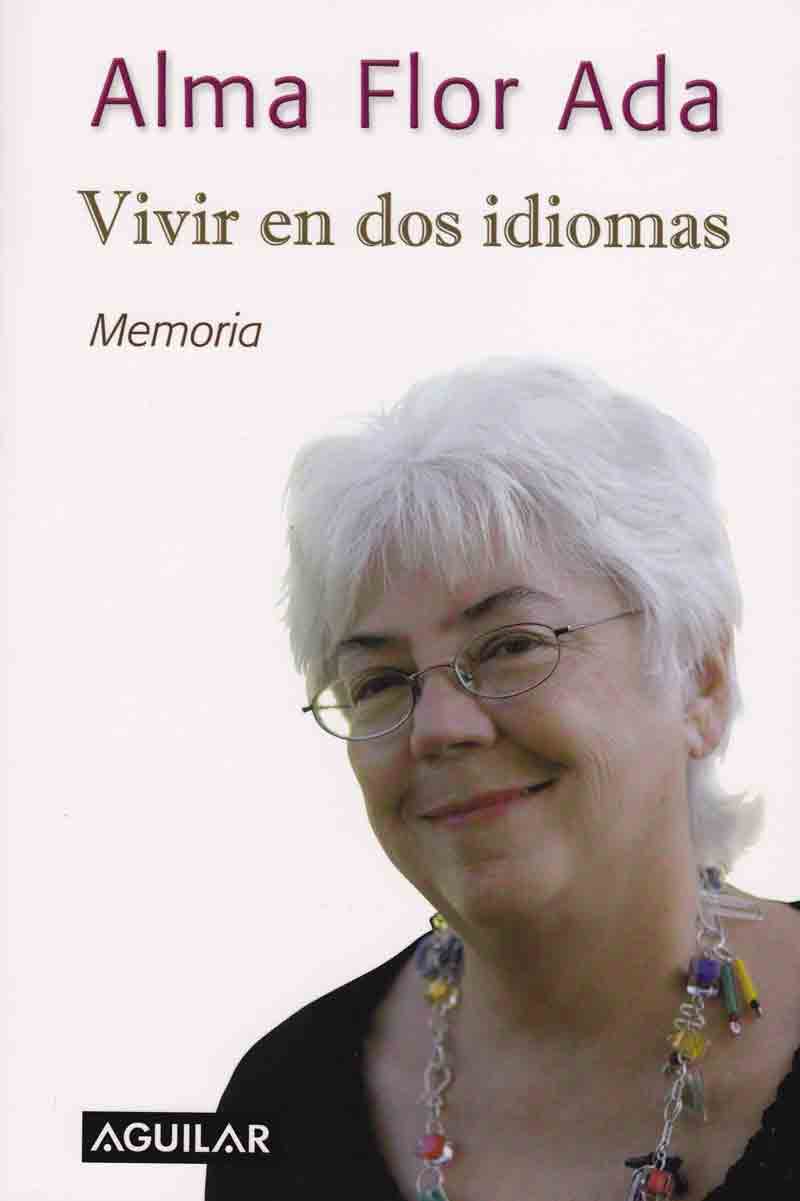 Vivir
en Dos Idiomas
Vivir
en Dos Idiomas
Readers
of Alma Flor Ada’s books and participants in her presentations have been
waiting for this book in which she tells the story of her own life.
"Vivir en dos idiomas is positioned somewhere between literature and history; it is not, however, a work of fiction.'' Using her signature style, Alma Flor Ada crafts an inspiring, intense, and personal examination of her life. This memoir presents the most significant experiences of a writer for whom narrating is synonymous with being, and an engagement that she cannot live without. From the very first pages we discover an extraordinary, gifted life. The author recounts the smallest aspects of an apparently idyllic childhood spent in Cuba -her first school years, and the first encounters with what would later become much more than inseparable companions: books. We will journey with her through ups and downs, through cities and countries in three continents. We will also witness the key incidents that led to her unflagging support of peasant immigrants in the United States. With exemplary style, Alma Flor Ada reveals the story of her career and invites us to find in books a new best friend.
''He vivido sin esperar premio ni castigo, y ahora descubro que el premio ha sido cada dÃa vivido.'' Vivir en dos idiomas se ubica en la frontera entre la literatura y la historia. Desde las primeras paginas descubrimos una vida tocada por un don. Con la sinceridad que la caracteriza, la autora hace una exploracion personal, intensa e inspiradora de su propia vida. Este libro presenta las experiencias y reflexiones mas significativas de una escritora para quien la narracion es parte del ser, un compromiso inaplazable. Con su inconfundible estilo, Alma Flor Ada nos relata los pormenores de una infancia aparentemente idiica en Cuba, sus anos de escuela y sus primeros encuentros con los libros, que mas tarde se convertirian en companeros inseparables, amigos, confidentes y portadores de su mensaje. La acompanaremos en su travesia, llena de avatares y logros, por distintos paises de tres continentes. Seremos testigos de episodios que marcarian para siempre su camino, como el contacto con maestros como Paulo Freire y las situaciones de injusticia social que motivaron su infatigable labor en pro de los campesinos inmigrantes en Estados Unidos. En estas paginas Alma Flor Ada nos ofrece, lejos de los reflectores de la figura publica, la posibilidad de ser sus companeros de viaje, mientras revela los secretos de su apasionante trayectoria.
It
was indeed a challenging process to decide what from my very long and rich life
to include in a book of memoirs, and a challenge as well to decide on the style
of the book.
The
book was started initially at the suggestion of Amaya Elezcano, a wonderful
Alfaguara editor in Madrid, Spain, who encouraged me to work on a series of
three books corresponding to different phases of my life. Later, another
talented editor from the Alfaguara group, Silvia Matute, decided to publish the
work in the Aguilar autobiographical collection as a book with three distinct
parts.
The
first section, Porque empecé a vivir [Because Life Began][G1] covers the years
from age fifteen to twenty, when I lived partly in Cuba, partly in the United
States. It explores my first experiences of living in a different country, of
trying to study and learn in another language, of awakening to the destructive
forces of racism and discrimination which could lead people to renounce their
own language and identity. The reflections brought about by these experiences
would have a lasting influence on my life. There are also more intimate
reflections about my own spiritual search.
The
style of this first part is different from the other two. Because Cuba played
such an important role in defining my experiences, I felt the need to share some
sociocultural content with the reader. To that end, each chapter is preceded by
a vignette depicting a specific geographical, social or cultural aspect of my
country that frames, or influences, the personal experiences.
The
second part of the book, La lengua se hizo matria [Language Became the
Motherland] covers the period of my life from twenty to thirty-two years of age.
During that time, I lived and studied in Madrid, Spain and in Lima, Peru, and
did postdoctoral research work at Harvard University through the Radcliffe
Institute. It was a period of great change in my life. While I insist that I
have never left Cuba, which is so much a part of me, I had to learn to live
outside of my country, and far away from everyone I knew and loved. During that
period I developed a profound love for another country, Peru, completed a
doctorate, met some extraordinary teachers, and began publishing. But above all,
during that time I began my lifelong work as a bilingual educator and the
essence of my whole being was transformed as I became a mother.
The
third part of the book covers some of the work experiences and ongoing
reflections that have made up my life of advocacy in the United States since
1970. It explores the influence that Paulo Freire has had on my life and work,
as well as what I have gained from working with farmworking families and from
the dialogic process of learning alongside my doctoral students at the
University of San Francisco and all the teachers whose classes and schools I
have been privileged to visit.
Embarking
on the introspective journey that writing a memoir requires is both difficult
and demanding. At times, one is drawn so strongly into the past that it becomes
difficult to be present in the here and now. Some of the memories are painful
and haunting and if, until now, they have been explored only superficially,
facing them may indeed be a hard task. Yet, how rewarding to be able to revisit
one's life!
A
popular Latin American song says: Recuérdame, que recordar es volver a vivir...
[Remember me, for to remember is to live again...]. And of course, that means to
live again both joys and sorrows, successes and mistakes, presences and losses.
But above all, to remember is to accept the opportunity to keep on learning from
life... and I, for one, found there is much still to learn.
Sharing
it, amidst smiles and tears, has been an act of love. It started with finding
compassion for the many persons I have been, from girlhood to adulthood, but
became above all an expression of love for all who in one way or another have
been part of the story, and for the unknown readers who may find in these pages,
I hope, an invitation to explore their own inner journeys.
But
no matter how long, rich, and diverse the experience, there is one word that
sums it up perfectly, a word that expresses the overwhelming feeling that is
left at the end of the process: gratitude.
Thanks
to life, to existence, to everyone I have encountered along the way, and to each
day.
I
have lived without expecting either punishment or reward. Now I discover the
reward has been each day I have lived!
Noticias Terra : La cuentista y educadora cubana Alma Flor Ada revela en sus memorias una vida marcada por la lectura, los viajes y los recuerdos de su patria. Aunque la prolífica escritora ya había detallado en dos libros anteriores su quehacer literario y las historias personales que dieron lugar a cuentos y poemas, en "Vivir en dos idiomas" Ada examina los eventos más significativos de su vida para un público lector adulto. Dividido en tres partes, "Vivir en dos idiomas" se lee en ocasiones como un diario de viajes, pues son muchas las culturas con las cuales Ada ha entrado en contacto, a través de sus estudios, viajes y lecturas. La primera sección, sin embargo, tiene un tono particular que la distingue de las otras dos, ya que medita sobre el contexto cultural en que creció, salpicando su relato con canciones, anécdotas y poemas. Esta parte recoge recuerdos y relatos de su querida Cuba al igual que sus primeros encuentros con la cultura estadounidense. La segunda parte, trata de su formación académica en España, Perú y EEUU y su transformación personal al hacerse madre. Y la tercera aborda su labor educativa y literaria en EEUU, donde ha residido desde 1970, y la influencia de Paulo Freire en su incansable labor social. Muy pronto en la lectura nos damos cuenta que la infancia de Ada fue privilegiada, no sólo por la soltura económica de su familia, sino por haber contado con el apoyo de sus padres para explorar intereses a menudo contrarios a las normas sociales de la época. Ada recuerda, por ejemplo, que al cumplir los quince años, sus padres le dieron la opción de pasar un verano en un campamento en el extranjero en lugar de marcar la ocasión con una fiesta, como era habitual para entonces. Lectora y estudiante voraz, Ada aprovecha la oportunidad para asistir a un colegio de niñas en Pennsylvania, donde además de aprender inglés con compañeras igualmente privilegiadas, observa por primera vez el maltrato al que eran sometidas algunas de sus compañeras por pertenecer a un grupo minoritario. El tono de "Vivir", sin embargo, no resulta pomposo, sino sincero y agradecido. Si bien resulta admirable que en su itinerante vida la escritora haya siempre obrado con tal rectitud, identificándose contra toda injusticia y logrando efectuar cambios verdaderamente asombrosos, es preciso recordar que en la lectura de autobiografía a veces se dice más en lo que queda fuera que en lo que se incluye. Las memorias literarias tienden a no diferir tanto de la buena ficción, en que nos invitan a reflexionar sobre nuestra humanidad y a llegar a nuestras propias lecciones, si es que las hay. Desafortunadamente, en más de una ocasión las memorias de Ada adolecen de didactismo. En una anécdota particularmente resonante, Ada recuerda su trabajo aun de estudiante en un orfanato de Denver. Ada y unas compañeras solían ayudar a bañar a los niños, muchos de los cuales eran hispanos, y les contaban historias en español e inglés después de terminar sus quehaceres. Un día, Ada cargaba a una niñita de tres años a quien le había tomado un cariño especial. Comenzó a contarle un cuento en inglés y la niñita la interrumpió para pedirle, en inglés, que lo hiciera "de la otra manera". Como la niña le hablaba en inglés, Ada le preguntó que por qué quería que le hablara en español. La chiquita le contestó: "Porque así se oía mi madre". Podemos imaginar el efecto que esta experiencia pudo tener en la joven Ada y deducir la importancia de la relación afectiva de los niños con la lengua materna. En este caso, como en muchos otros, la anécdota desnuda, sin comentarios o explicaciones, hubiese resultado más efectiva que seguida de un párrafo explicativo como aparece. Aún así, el libro describe la vida ejemplar de una escritora que ha dejado un importante y prolífico legado "en dos idiomas".
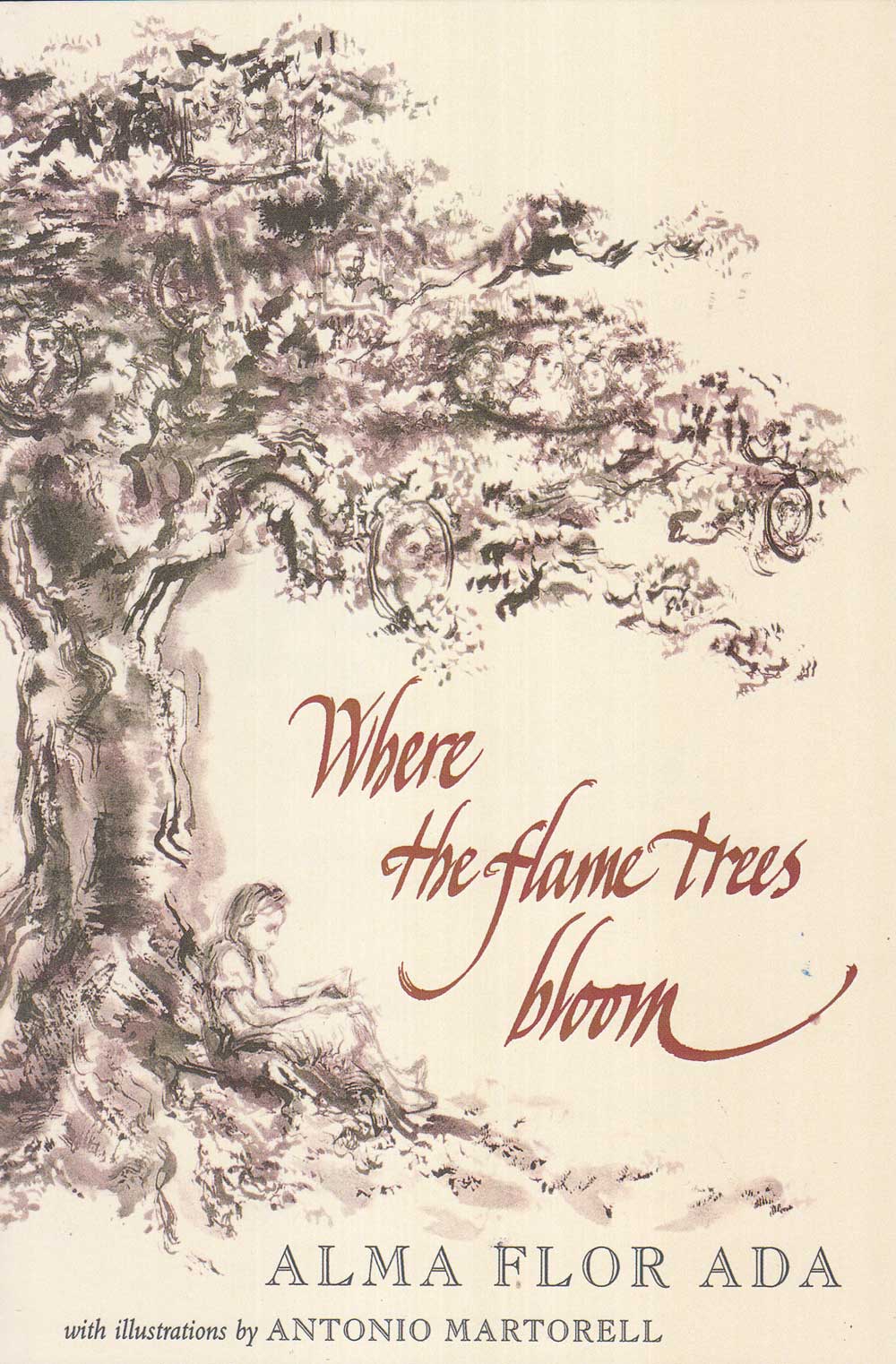 Where
the Flame Trees Bloom
Where
the Flame Trees Bloom
Center for Latin American Studies, America´s Commended List
Video : Colorin
Colorado Interview, Spanish
Video : Colorin
Colorado Interview, English
These true stories from Alma Flor Ada’s childhood are filled with family love and values. Told through the eyes of a child, a whole world comes to life for the reader: the blind great-grandmother who never went to school but whose wisdom and generosity overflowed to those around her; the hired hand Samoné whose love for music overcame all difficulties; her grandfather Modesto, who placed a higher value on human relationships than on his possessions. Eleven remarkable stories will move and inspire children and adults alike. Companion volume to Alma Flor Ada's "Under the Royal Palms"
School Library Journal : Grade 3-6 Those who wonder what "family values" really are may possibly find the answer in this slim volume of short stories. Telling of her childhood in Cuba, Ada begins with an introduction to her homeland followed by 11 episodes about her family and her community. One story tells of her grandfather Modesto's courage and loyalty in the face of the death of his beloved wife and the simultaneous collapse of the Cuban economy. Another tells of her great-grandmother Mina, who continued to make rag dolls for the village children even after she had lost her sight. And a third tale tells of a Japanese street vendor who sold ice cream for a living, but gave generous samples to children who could not afford to pay. Warmth and love for a treasured childhood exude from the pages. The writing is elegant, but not overly sweet. Each selection stands well on its own. Children can read this book independently or enjoy listening to it read aloud.
Listen to Vienna Rose read Where the Flame Trees Bloom to you. A marvelous example of the magical encounter between a child and books that we wish for all children. And here's an earlier reading by Vienna Rose.
The Book Nest : The novella is a series of vingettes, with each chapter as a titled story - I think my favorites were "Mathematics" and "The Rag Dolls," both of which are about her beloved great grandmother. Because of their elegant simplicty, I think these stories could be read with pleasure to (or by) children as young as 8 or 9, but appriciated on a different level by adults. Highly reommended. I feel like the world is a more beautiful place, having read this charming book. Alma Flor Ada takes us to the Cuba of her childhood, and reading her stories, I felt like I was sitting at the feet of a beloved Gramother, listening to her tell me of the life she knew. The stories feel that intimate and familiar. We meet people, both relatives and friends, who show compassion and a zest for life - from the blind great grandmother who can sew rag dolls by touch and the hired man who plays the accordian at night. The text was so lyrical, I truly felt like I was living amongst the trees and the memories of those people who made Alma into the woman she is.
School Library Journal : Grade 3-6-Those who wonder what "family values" really are may possibly find the answer in this slim volume of short stories. Telling of her childhood in Cuba, Ada begins with an introduction to her homeland followed by 11 episodes about her family and her community. One story tells of her grandfather Modesto's courage and loyalty in the face of the death of his beloved wife and the simultaneous collapse of the Cuban economy. Another tells of her great-grandmother Mina, who continued to make rag dolls for the village children even after she had lost her sight. And a third tale tells of a Japanese street vendor who sold ice cream for a living, but gave generous samples to children who could not afford to pay. Warmth and love for a treasured childhood exude from the pages. The writing is elegant, but not overly sweet. Each selection stands well on its own. Children can read this book independently or enjoy listening to it read aloud.
Where the Flame Trees Bloom, by Alma Flor Ada, is a lovely memoir of growing up in Cuba. A second volume is called Under the Royal Palms. She wrote these books for young people as a series of vignettes that tell about her family, her town, and her experiences growing up on the outskirts of a Cuban town called Camagüey. "My grandmother and one of my uncles were great storytellers. And every night, at bedtime, my father told me stories he invented to explain to me all that he knew about the history of the world. With all these storytellers around me, it is not a surprise that I like to tell stories." And the stories she shares are beautifully told. The very first story in Where the Flame Trees Bloom is my favorite, although I enjoyed each one. It is called "The Teacher," and recounts a poignant experience in the life of her grandmother. In the telling of this story, she captures a spontaneous teaching moment that reveals the heart of the teacher (her grandmother) and the ultimate purpose of teaching. I was very moved by this story and the way she told it. Here's an excerpt from it that was printed on the back cover of the book : "Look," continued my grandmother, as she pointed to the road that bordered the farm. There the students saw a solitary man walking. "Look at that old man. He is walking by us. In a few minutes he will be gone forever, and we will never have known who he is, where he is going, what may be important in his life." The students watched the man, who by then was quite close. He was very thin and a coarse guayabera hung loosely over his bent frame. His face, in the shade of a straw hat, was weathered and wrinkled. "Well," said my grandmother, "do we let him go away, forever unknown, or do you want to ask him if there is anything we can do for him?" These beautifully written little books would be a lovely way to introduce young people to the genre of memoirs. Both books are well worth reading for adults as well as for children.
To Order or to Ask
a Del Sol Question, read the Del
Sol Order Info and then email
Rey Del Sol
![]()
333 N Main Street, # 2464, Cedar City, UT, 84720
